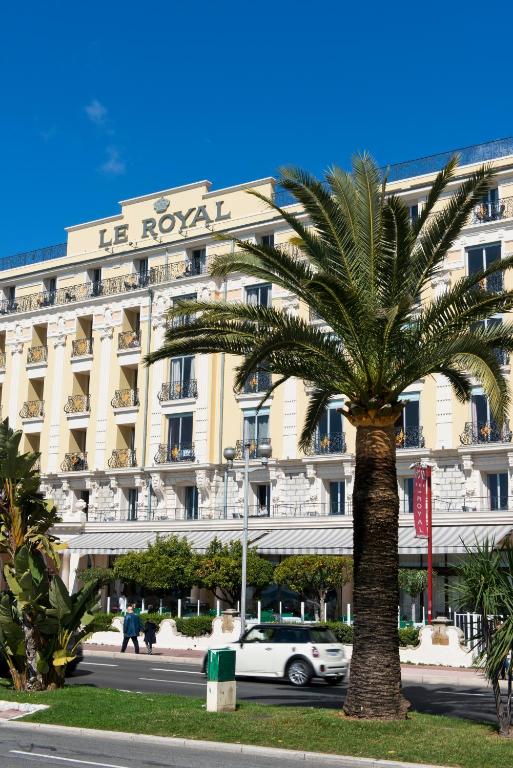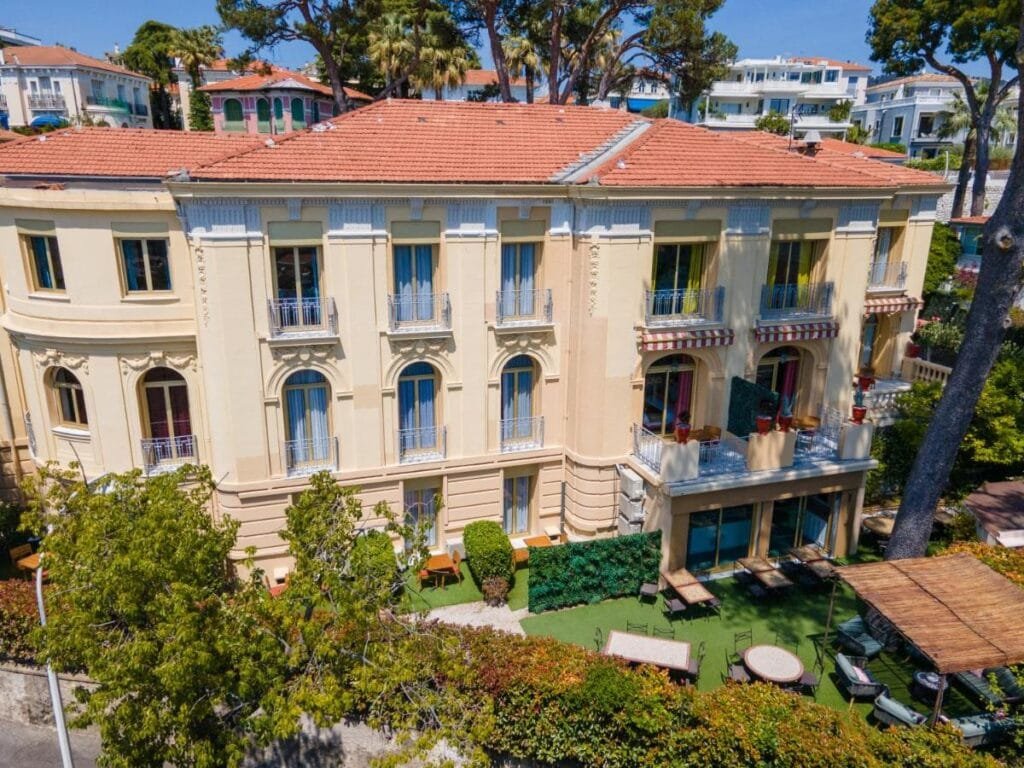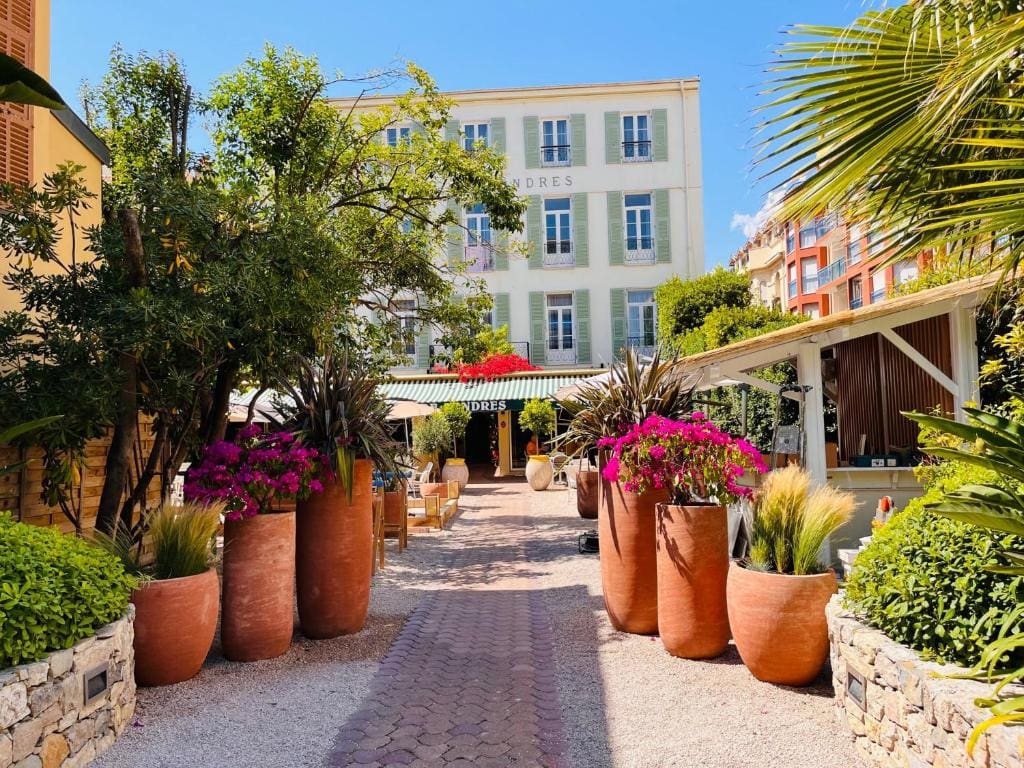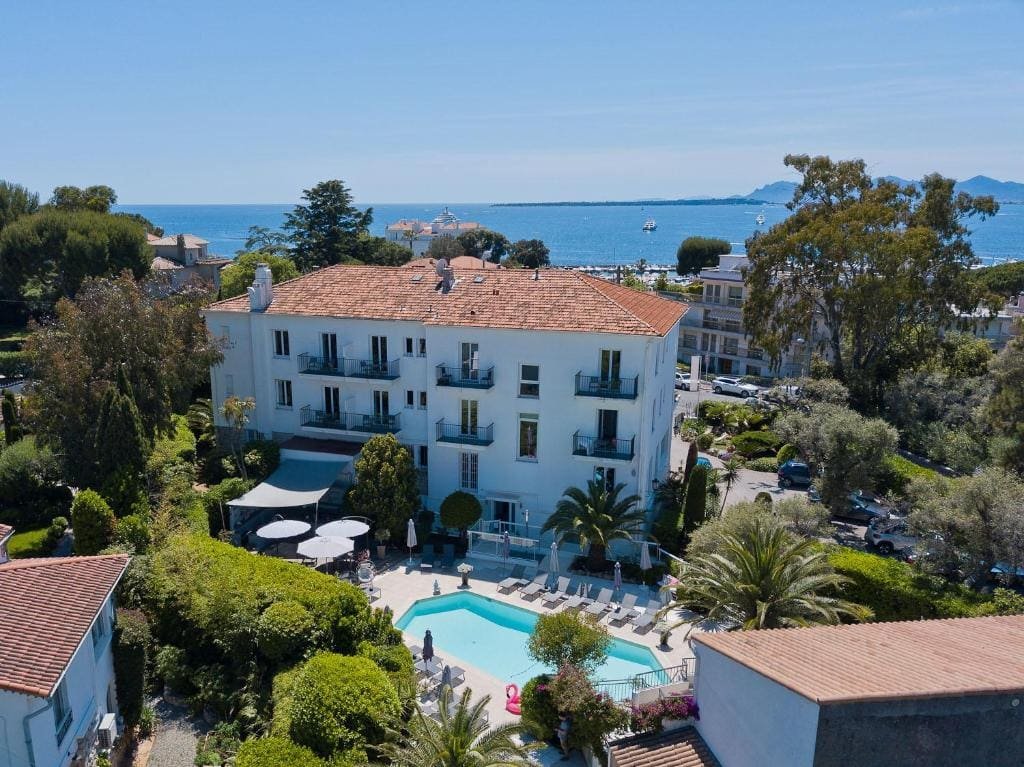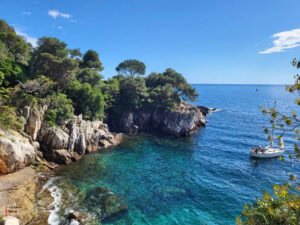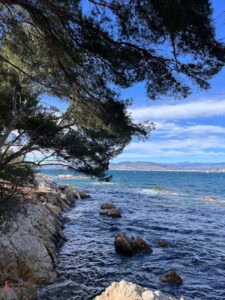Explore with Ersilia contains affiliate links and is a member of the Amazon Services LLC Associates Program. If you make a purchase using one of these links, I may receive compensation at no extra cost to you. affiliate links are how we keep this content free. A huge thanks if you use these as it helps a lot! See the Full Policy for more information.
As a Romanian who first came to France as an Erasmus student and now calls Toulouse home, I remember how the French Riviera seemed like this mythical, overwhelmingly glamorous destination. I kept asking myself all these questions: How much time would I need to see everything? Would it be way too expensive? Should I save it for a once-in-a-lifetime special occasion?
Let me tell you – I was completely wrong about needing a celebrity’s budget or weeks of vacation time! After actually visiting the Côte d’Azur, I discovered that you can experience the best of this stunning region in just 5 days, and yes, even on a reasonable budget. From finding charming local restaurants in Nice’s old town to discovering free walking trails with million-dollar views, there are so many ways to enjoy the French Riviera without breaking the bank.
I had such an amazing time that I’m already planning my next trip back! So let me share my perfectly crafted 5-day French Riviera itinerary that will help you experience the highlights of this beautiful coastline – from the charming old town of Nice to the glittering casinos of Monaco. Trust me, with some smart planning, you can make your French Riviera dreams come true!
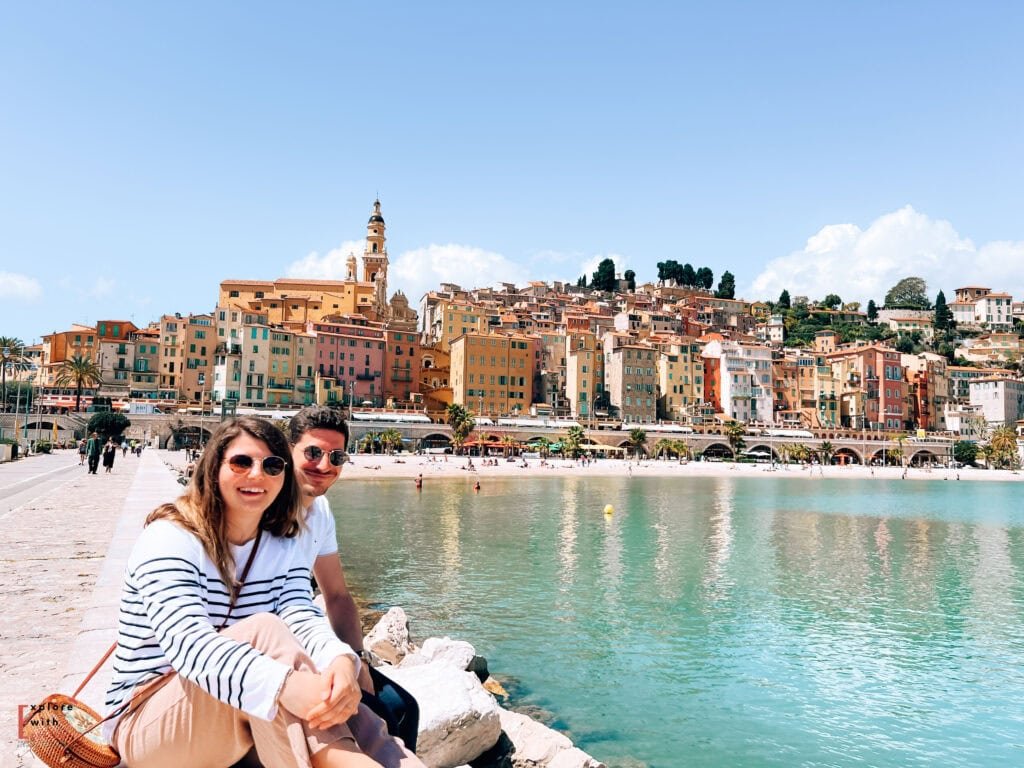
Where is the French Riviera?
The French Riviera (Côte d’Azur) graces the southern coast of France in western Europe, stretching from the Italian border near Menton in the east to around Saint Tropez in the west. This stunning coastline encompasses everything from bustling Mediterranean coastal towns to medieval villages France is famous for, creating a perfect blend of history and seaside charm.
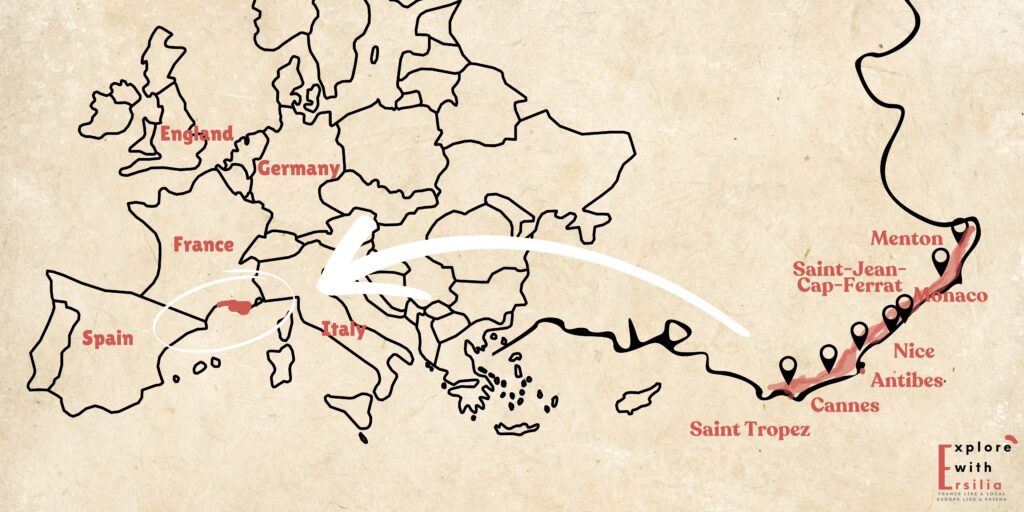
When to Visit the French Riviera
The best time to visit the French Riviera depends on your priorities, but I’ve discovered some insider tips after multiple visits. Spring travel to France, particularly April to June, offers perfect temperatures, blooming Mediterranean gardens, and reasonable prices. The fall vacation French Riviera experience (September-October) mirrors these ideal conditions, with the added bonus of warm sea temperatures for swimming.
I absolutely love spring on the French Riviera – the weather is perfect for exploring coastal hiking trails and wandering through Provence markets without the summer crowds. Plus, shoulder season means you’ll find better deals on French Riviera accommodation and more availability at popular restaurants.
Here’s my crucial tip: avoid August at all costs. Not only do prices skyrocket and crowds reach their peak (most French people take their vacation this month), but the heat can make midday sightseeing unbearable. Instead, plan your visit during shoulder season when you can fully enjoy both cultural attractions Côte d’Azur offers and the natural beauty of the Mediterranean coast.
How to Get to the French Riviera
Flying to Nice Airport
The most straightforward option is flying directly to Nice Côte d’Azur Airport. As the main gateway to the French Riviera, it welcomes flights from major European cities and international destinations. From the airport, you can easily reach Nice city center via tram or bus.
Coming from Paris
If you’re already in Paris, you have two main options:
The train journey from Paris to Nice takes about 6 hours, but don’t let the duration put you off! With tickets starting at just 25 euros when booked in advance, it’s both budget-friendly and surprisingly convenient. Here’s why I prefer this option:
Option 1: Train Ride (My Recommended Choice)
- No need to travel to Paris’s outer airports (saving 1+ hour)
- No early airport arrival required (unlike the 2-hour recommendation for flights)
- Comfortable seats with power outlets and plenty of legroom
- Beautiful views of the French countryside
- Arrive directly in Nice city center
When you add up the time needed to reach Paris airports (1 hour), airport waiting time (2 hours), the flight itself (1 hour), and travel from Nice airport to the center, the total journey time isn’t actually much different from the train.
If you choose the train, book your tickets through SNCF’s website as early as possible – ideally 3-4 months in advance for the best prices.
Option 2: Flying
While the actual flight is only one hour, remember to consider these:
- Getting to either Charles de Gaulle or Orly Airport (1 hour from Paris center)
- Airport check-in and security (recommended 2 hours before flight)
- Travel from Nice Airport to your accommodation
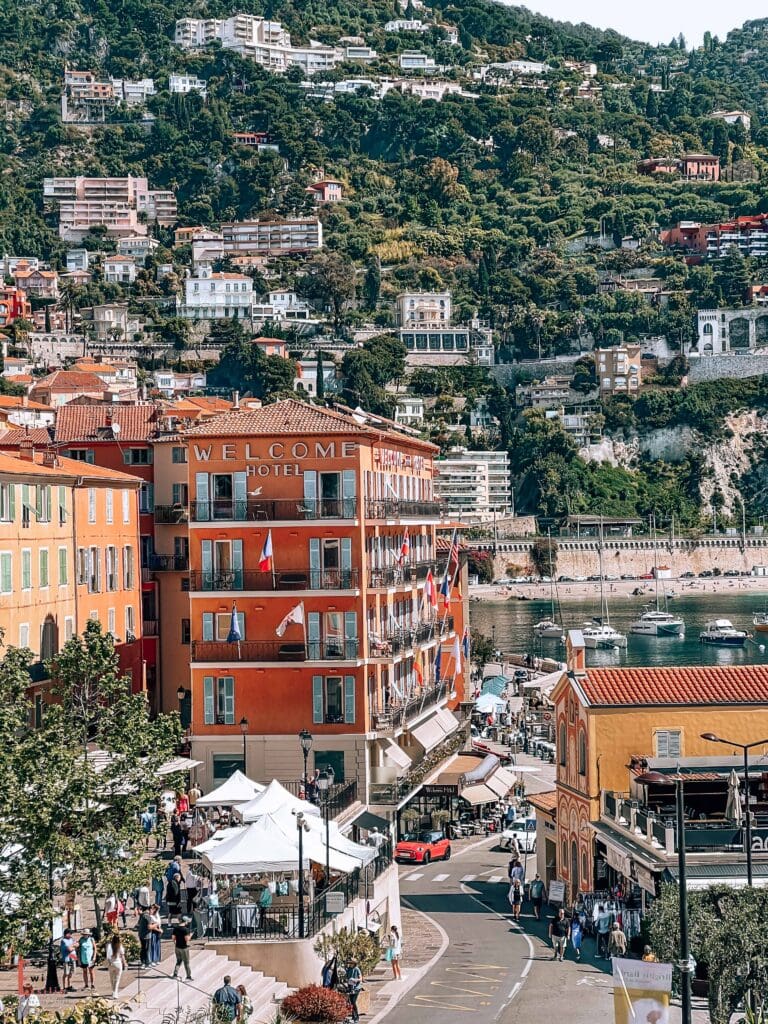
Is 5 Days in the French Riviera Enough?
Five days gives you the perfect introduction to the French Riviera’s highlights. You’ll have time to explore Nice’s winding streets, wander through medieval villages like Èze, experience Monaco’s glamour, discover Antibes’ coastal charm, and still find moments to relax on Mediterranean beaches.
Of course, you could easily spend weeks exploring the region’s hidden coves, hilltop villages, and cultural attractions. But five days strikes an ideal balance – enough time to experience the essentials without feeling rushed. The itinerary I’ve crafted includes the must-see destinations while leaving room for spontaneous discoveries.
Want to extend your stay? Each destination in this guide could merit an extra day or two, especially if you prefer a slower travel pace or want to dive deeper into specific interests like art, cuisine, or coastal hiking.
Where to Base Yourself on the French Riviera for a short week itinerary
Based on my experiences visiting the French Riviera and living in France, Nice emerges as the most practical base for a short stay. The city’s central location and reliable public transportation network make it ideal for exploring the coastline. Whether you’re planning day trips to Monaco or visits to nearby medieval towns, Nice’s train station and bus terminal provide convenient connections to most destinations.
Nice also offers an impressive range of accommodation options to suit different budgets. From comfortable hostels to luxury hotels, you’ll find choices for every price point.
$Here are the main areas I’ve explored in Nice:
The Old Town (Vieux Nice) puts you right in the historic center. Staying here means being steps away from local restaurants and the famous Cours Saleya market. Just keep in mind that the medieval streets can get lively in the evenings, especially during high season.
The Promenade des Anglais area offers that quintessential French Riviera experience. While hotels here tend to be more expensive, you get stunning Mediterranean views and easy beach access. It’s also convenient for morning walks and evening strolls along the coast.
If you’re looking for alternatives to Nice, here are two other bases I’ve discovered:
Menton charmed me with its colorful buildings and authentic atmosphere. I particularly loved its painted houses and the peaceful waterfront. While it requires longer travel times to reach other destinations (about 40 minutes by train to Nice), its beautiful beaches and proximity to the Italian border make it a unique choice. Being this close to Italy means you could even squeeze in a day trip to San Remo if you have time !
Antibes struck me as a perfect middle option. Its location makes day trips manageable, while its historic ramparts and beaches provide plenty to explore locally. The old town retains much of its medieval character, and the famous Port Vauban adds a touch of Riviera glamour with its impressive yachts.
Regardless of which base you choose, I recommend booking accommodation well in advance, especially if you’re visiting during popular events like the Cannes Film Festival in May or Nice Carnival in February.
This 5-Day French Riviera Itinerary at a Glance
This itinerary combines medieval villages, coastal towns, and cultural highlights while balancing popular attractions with hidden gems. Adjust the days based on your interests and energy levels – it’s your vacation after all!
Day 1
Nice
Base yourself in Nice and explore the historic Old Town. Start at the colorful Cours Saleya market, discover hidden gems like Palais Lascaris, and don’t miss the panoramic views from Castle Hill. End your day with a sunset stroll along the famous Promenade des Anglais.
Top tip: Download the Navaway app for guided walking tours of Nice’s highlights.
Day 2 Monaco & Èze village
Start early in the medieval village of Èze (arrive before the tour buses!). Explore its exotic gardens and enjoy spectacular Mediterranean views. Spend the afternoon discovering Monaco’s glamour – from the Prince’s Palace to Monte Carlo Casino. Don’t miss the evening fountain show at the Japanese Gardens.
Top tip: Pack a picnic to enjoy in Monaco’s Japanese Gardens instead of expensive restaurants.
Day 3
Antibes & Juan-les-Pins
Begin at Antibes’ Provençal Market and the Picasso Museum. Take the stunning coastal walk around Cap d’Antibes, then spend the afternoon relaxing on Juan-les-Pins’ beaches. Perfect for combining culture with beach time.
Top tip: Use the public beaches in Juan-les-Pins instead of expensive private ones.
Day 4
Saint-Paul-de-Vence & Grasse
Explore the artistic village of Saint-Paul-de-Vence in the morning, then head to Grasse, the perfume capital. Take a free perfume factory tour and wander under the famous pink umbrella street.
Top tip: Take Bus 400 from Nice to Saint-Paul-de-Vence – it’s just €1.50 each way.
Day 5
Villefranche-sur-Mer & Saint-Jean-Cap-Ferrat
Start in colorful Villefranche-sur-Mer, then visit the stunning Villa Ephrussi de Rothschild. Take the coastal path around Saint-Jean-Cap-Ferrat for incredible views (about 2 hours walk).
Top tip: Time your Villa Ephrussi visit with the musical fountain shows every 20 minutes.
Day 1: Nice – Your Perfect Home Base
Before I share my perfect day in Nice, let me tell you about a game-changing discovery: the Navaway app. When I first visited Nice, I was worried about missing out on hidden gems and historical spots. This app completely transformed my experience with its audio guides and carefully crafted itineraries. Trust me, download it before your trip – you’ll thank me later!
I have put together a map of Nice with all the places I mention in this article. You can save it for offline use !
Morning: Discovering Old Town’s Treasures
Start your day early at the Cours Saleya market. I can’t emphasize this enough – arrive before 9 AM! I made the mistake of coming later once and could barely move through the crowds. The morning light creates this magical atmosphere as vendors set up their colorful displays of fresh produce and fragrant flowers.
From Tuesday to Sunday, the market comes alive with colorful flower stalls and regional specialties. The striped awnings protect mountains of fresh fruits, vegetables, and Provençal delicacies from the warm Mediterranean sun. Don’t miss the socca vendors – they serve this local chickpea pancake hot and crispy, straight from traditional copper pans.
On Mondays, the market transforms into an antiques market where you can hunt for vintage treasures and French brocante. Arrive early (before 9 AM) to avoid the crowds and experience the market at its most authentic, when local chefs are selecting their ingredients for the day.
Head to the back corners of the market for the best prices, where you’ll find the same quality produce that the tourist-facing stalls offer, but often at lower prices. Also, prices tend to drop slightly in the last hour before closing, especially for fresh produce.
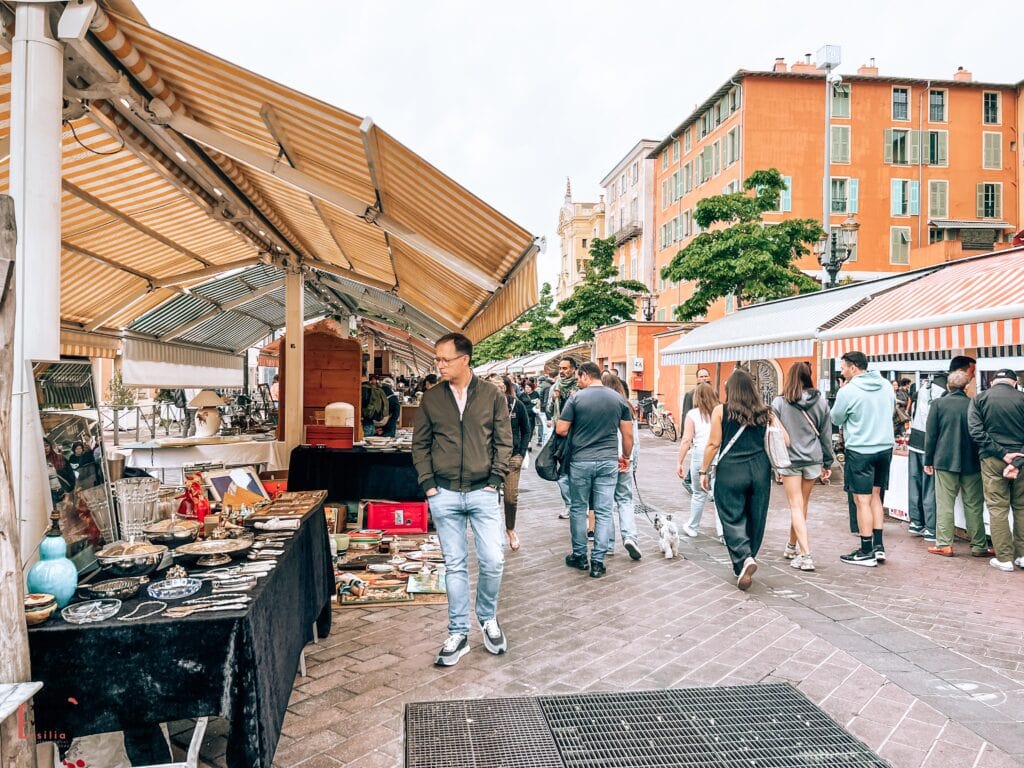
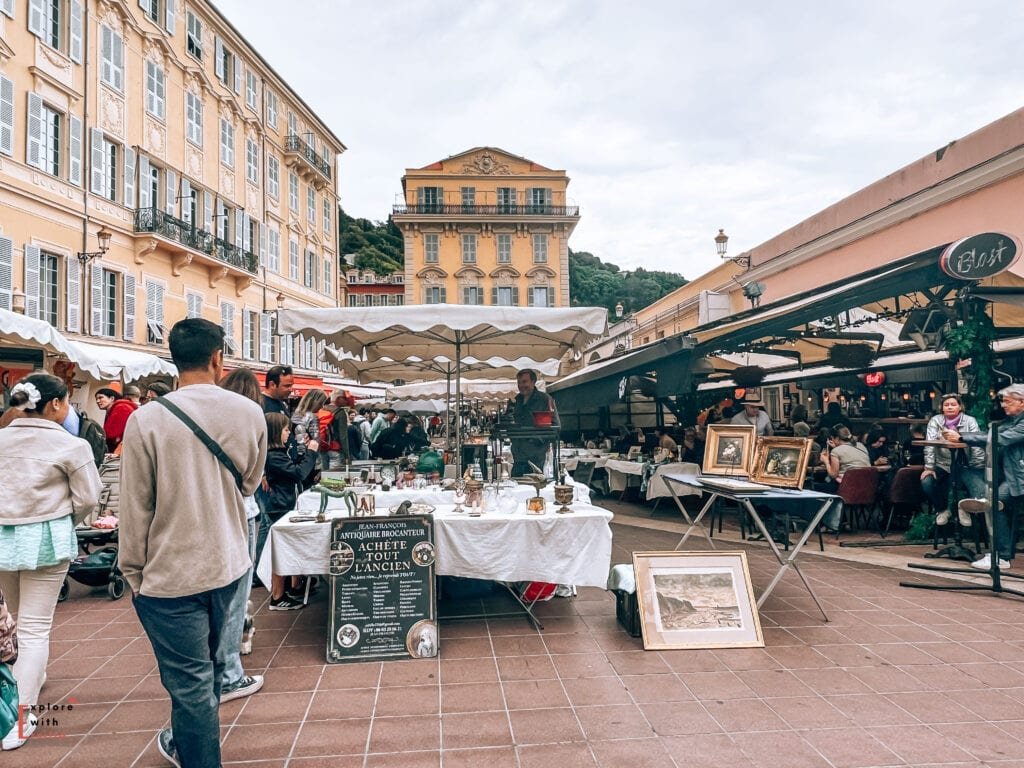
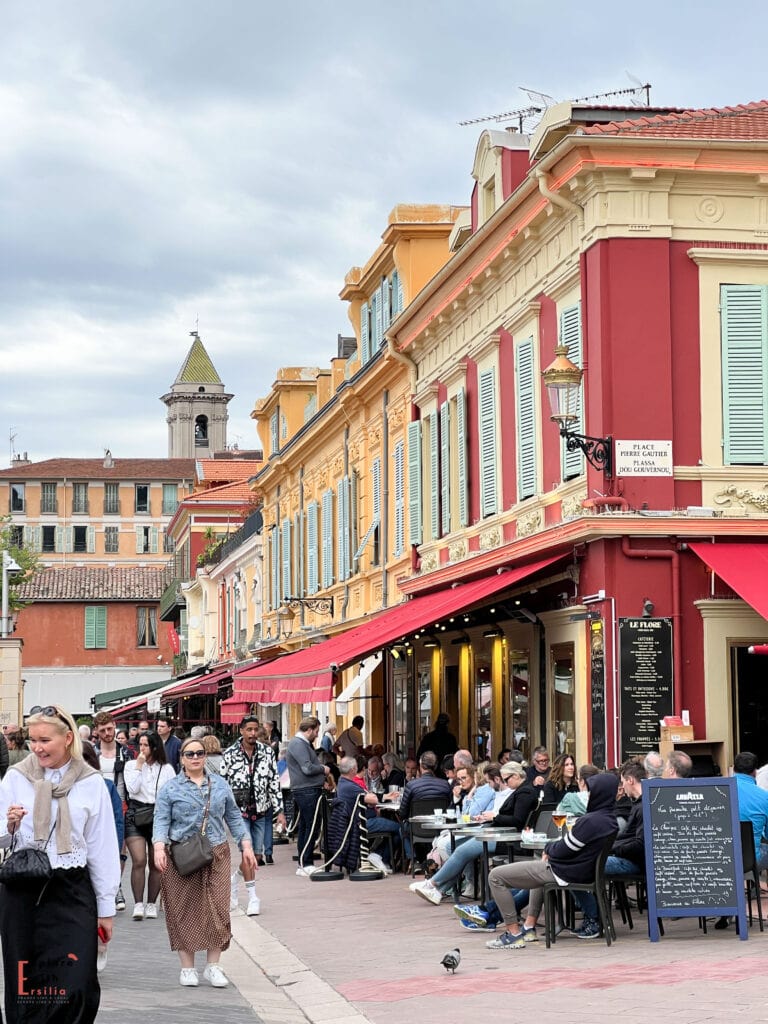
As you wander through the winding streets of Vieille Ville, make sure to seek out Rue Jules Gilly. This charming street perfectly captures Nice’s Italian heritage with its colorful buildings and traditional shops. I spent nearly an hour here, popping into little boutiques and admiring the architecture that reminds you that Nice was once more Italian than French.
The rich Italian heritage of Nice is deeply woven into the city’s architectural fabric, particularly in the Old Town (Vieux Nice). Until 1860, Nice was part of the Kingdom of Sardinia, and this long period of Italian rule left an indelible mark on the city’s character. The narrow winding streets, known as “carruggi” (a Genoese word), mirror the layout of Italian medieval towns, while the warm-colored facades in shades of ochre, terracotta, and yellow are reminiscent of those in Turin, Genoa, and other northern Italian cities.
Even the local dialect, Nissart, reflects this heritage, incorporating many Italian words. The famous Cours Saleya, with its vibrant market and restaurant terraces, follows the Italian tradition of outdoor commerce and dining, while the shuttered windows and painted facades create an atmosphere more reminiscent of Liguria than typical French cities.
This Italian influence creates a unique architectural blend that distinguishes Nice from other French Riviera towns, making it a fascinating example of cross-cultural heritage on the Mediterranean coast.
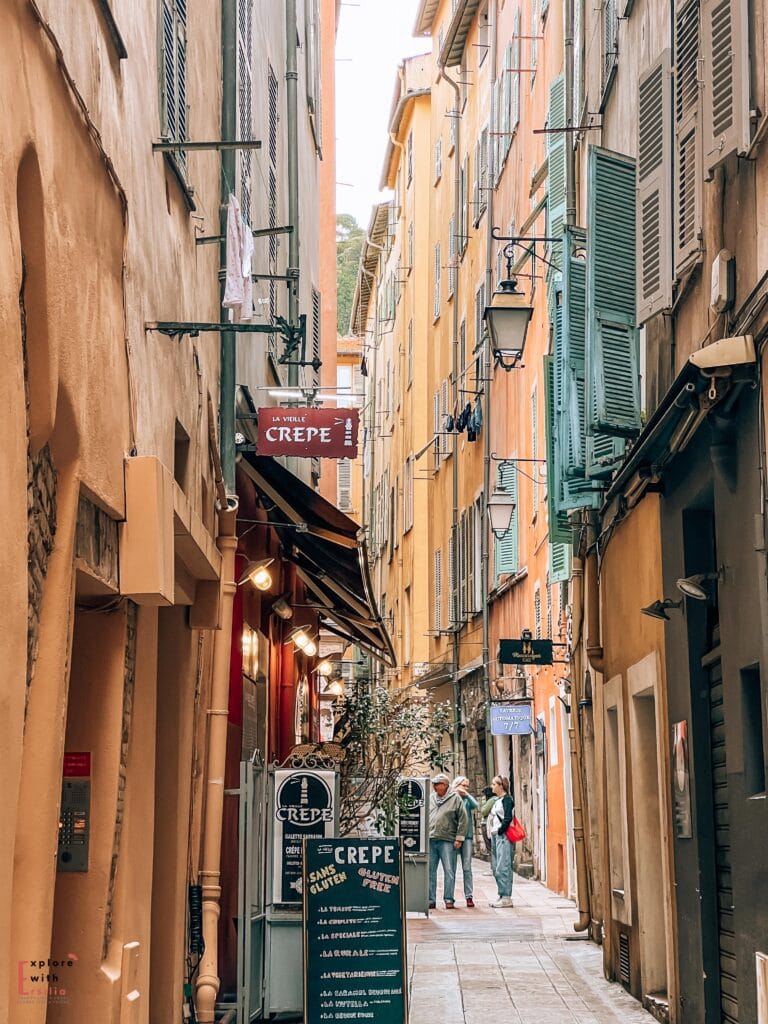
When you need a sweet break, head to “Oui, Jelato” near the Palais de Justice, just steps away from the Saleya market. Trust me on this one – their gelato is absolutely incredible! The quality and flavors are some of the best I’ve found outside of Italy. It’s the perfect treat while you make your way to the baroque Cathédrale Sainte-Réparate.
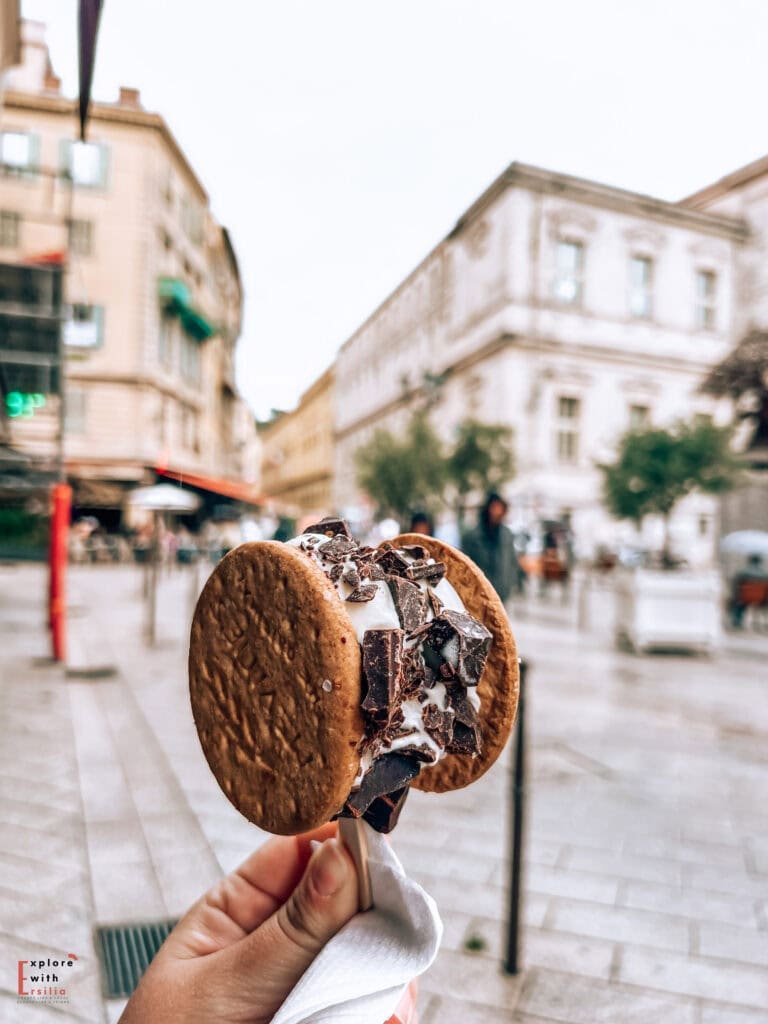

But here’s something most tourists miss – the absolutely stunning Palais Lascaris. This place completely stole my heart! Hidden in the heart of the old town, it’s one of Nice’s most beautiful museums, though surprisingly under-visited.
Walking through the Palais Lascaris feels like stepping back into the 17th and 18th centuries. The interiors are preserved exactly as they were, and as a music lover, I was fascinated by their incredible collection of antique instruments. Seeing the evolution of pianos and violins through the centuries gave me a whole new appreciation for musical history.
Don’t leave the old town without stopping at Maison Auer. This historic confectionery has been making traditional candied fruits since 1820, and the shop itself is like a museum of French sweet-making tradition.
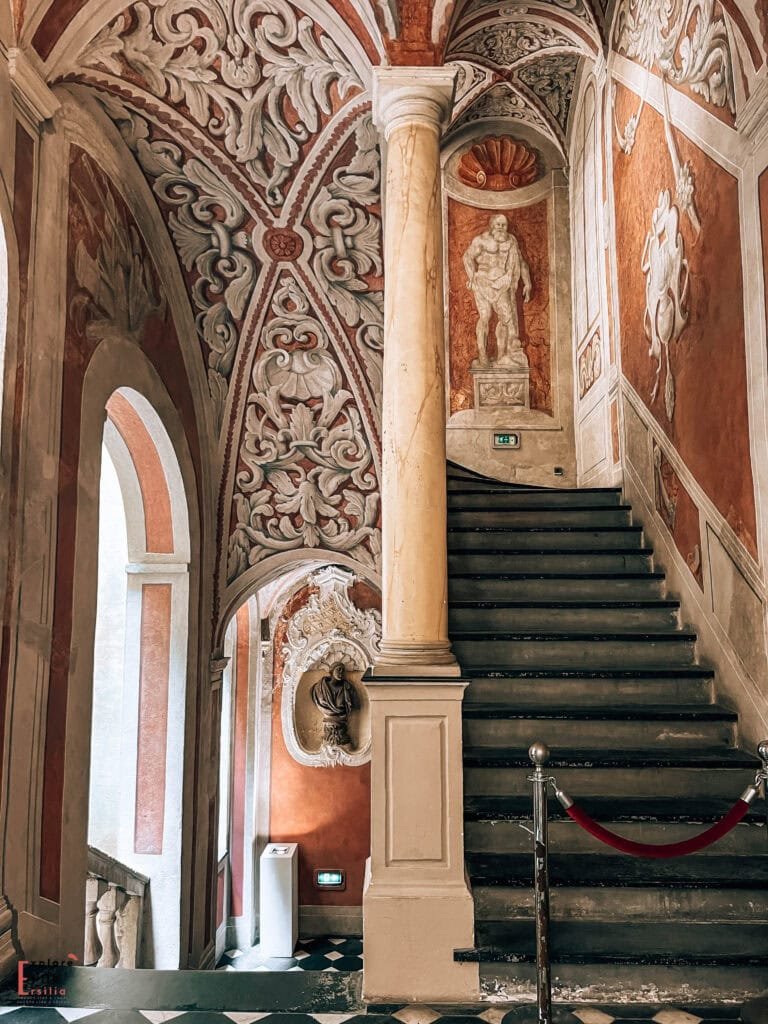
Afternoon: A Journey Through Time and Culture
After lunch, head up to the Matisse Museum in Cimiez. The 17th-century villa that houses it is worth the visit alone, but Matisse’s vibrant works in this setting are simply magical. Take time to explore the surrounding Roman ruins and Franciscan Monastery gardens – it’s a peaceful escape from the city buzz.
Make your way back down to Place Massena, where the checkered floor and beautiful red buildings create the perfect photo backdrop. I couldn’t stop taking pictures here! The fountains add this playful element to the square that just makes you want to linger.
The buildings surrounding the square wear a distinctive Genoese-Italian style, painted in that famous ochre-red color that’s become synonymous with Nice. Their deep red facades contrast beautifully with bright white trim and green shutters, all standing proudly under the intense blue Mediterranean sky.
The central fountain, dominated by the statue of Apollo, serves as a popular meeting point. Around it, the modern tram glides silently across the square, somehow managing to look perfectly at home against the classical architecture.
The Place connects the old and new parts of Nice – on one side, you’ll find the historic Old Town with its narrow streets, while the other leads to the modern shopping area of Avenue Jean Médecin. During summer evenings, the square buzzes with street performers, locals meeting for aperitifs, and the sound of music drifting from nearby cafes.
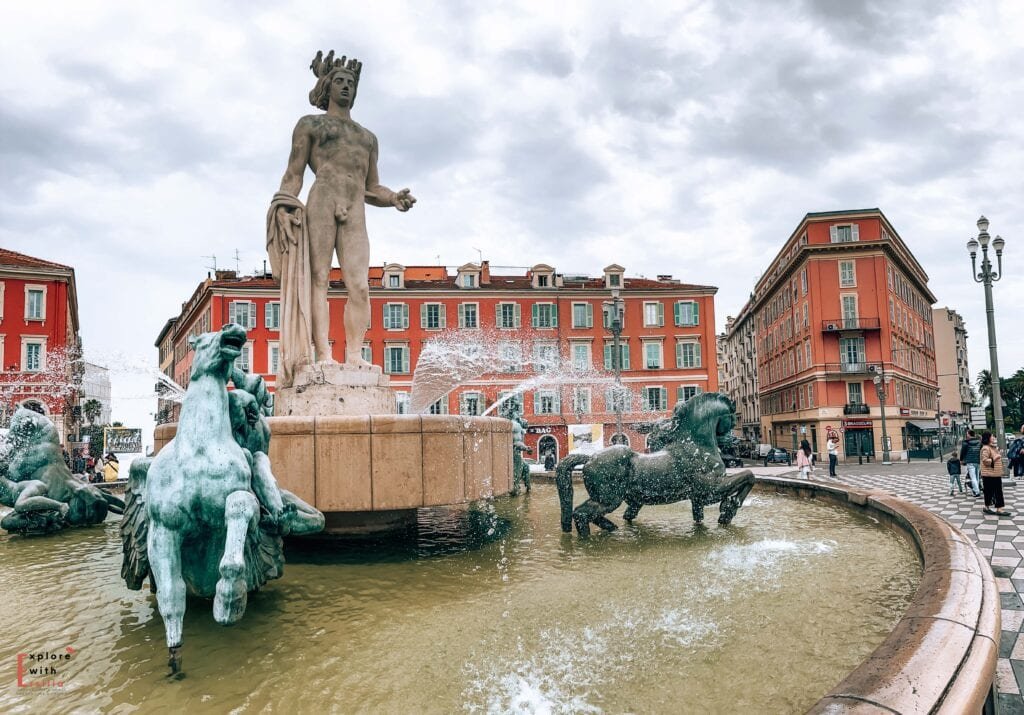
Here’s a local secret I discovered: take a break in the beautiful Jardin Albert 1er before exploring Rue de France. This street has such an fascinating history – it used to be the literal connection between old Nice and France before the city became French in 1860! I love walking down this street and imagining what it must have been like when Nice was its own little world.
Evening: Sunset Magic and Hidden Treasures
Now for the crown jewel of Nice – the famous Promenade des Anglais. The name has such a funny story behind it! It comes from the English visitors who used to take their daily walks here during winter, while locals thought they were crazy to walk in such “cold” weather. Today, you can channel that classic Riviera glamour by renting a striped sunbed on the beach. I did this and felt like I was in an old magazine photo!
Here’s something that made me giggle – Nice has its own Statue of Liberty! And when I say its own, I mean it’s one of the original prototypes for the New York statue. At just 1.30m tall, it’s absolutely tiny and easy to miss. I actually walked past it twice before finding it! But knowing that this little statue is connected to the iconic New York landmark makes it such a special discovery.
For sunset, head up to Castle Hill (Colline du Château). Sure, you could take the elevator, but I recommend walking up the stairs. Each step reveals a new stunning view of Nice, and the gradual climb makes the final vista even more rewarding. The panoramic viewpoint of the Castle Hill is the most known image of Nice, and once you get there, you understand why this view got to be so famous.
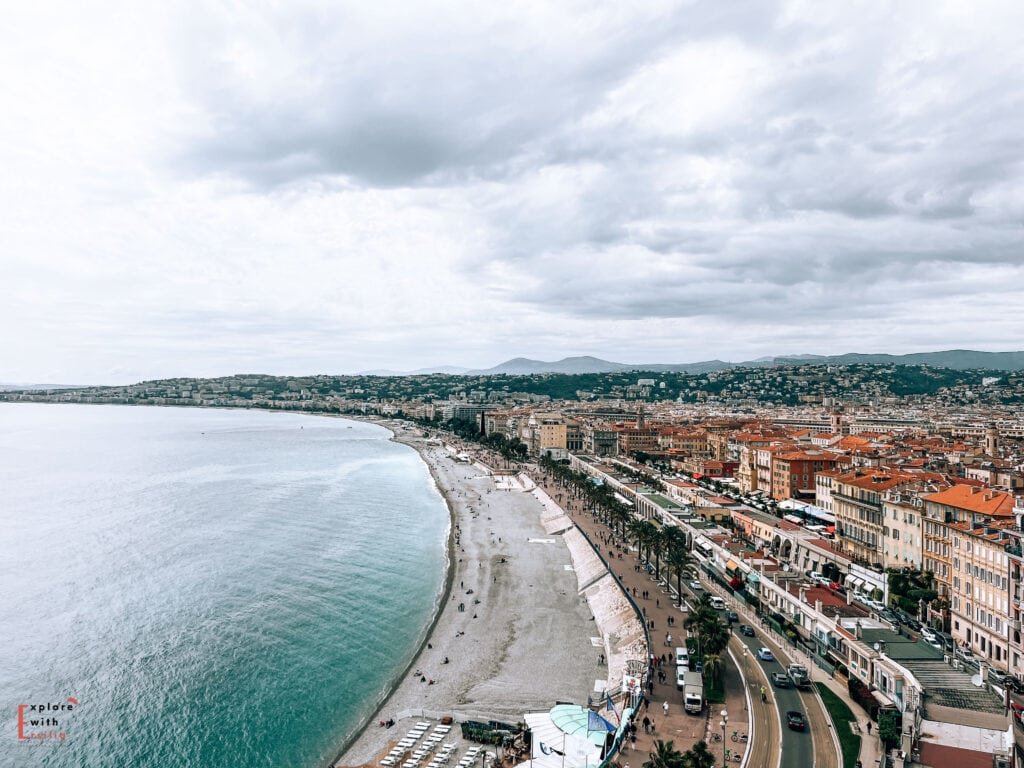
Don’t forget to look for the waterfall! I almost missed it my first time, but following the site markers led me to this beautiful surprise. From the hill, you’ll also get a perfect view of Port Lympia – it’s like discovering another face of Nice, with boats bobbing in the harbor and colorful buildings lining the water.
When you come back down, think about getting a picture with the famous 3D letters with the name of Nice : We love Nice! Around it, you will find an elevated waterfront path where you can either take a walk or sit and enjoy the emblematic sight.
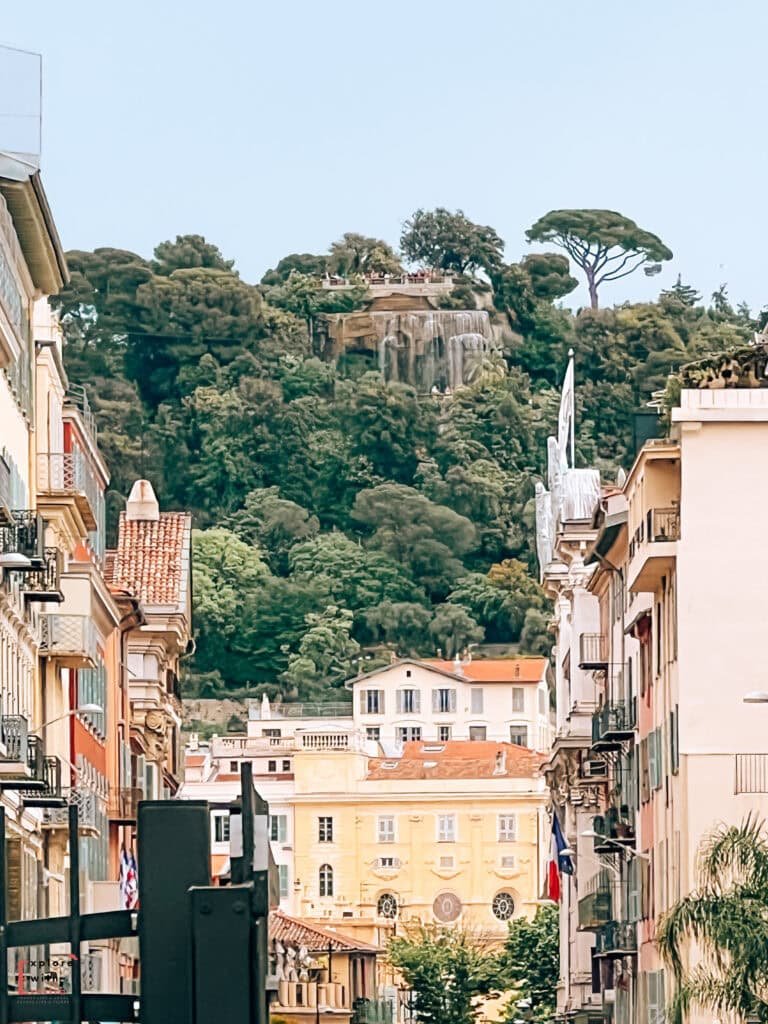
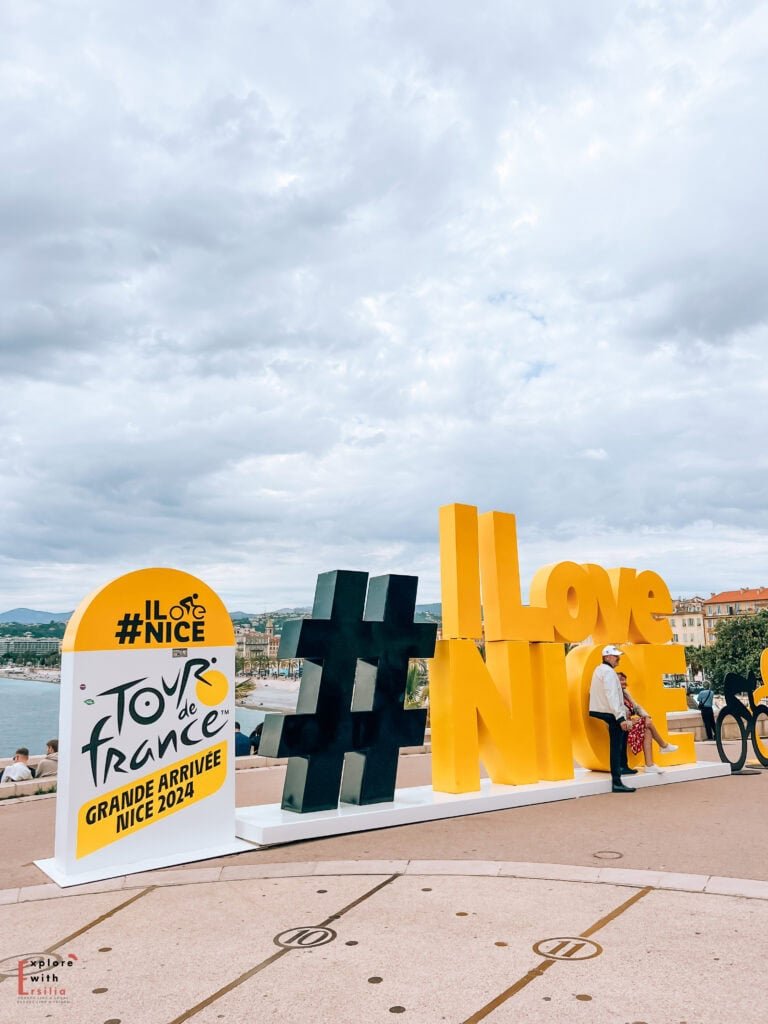
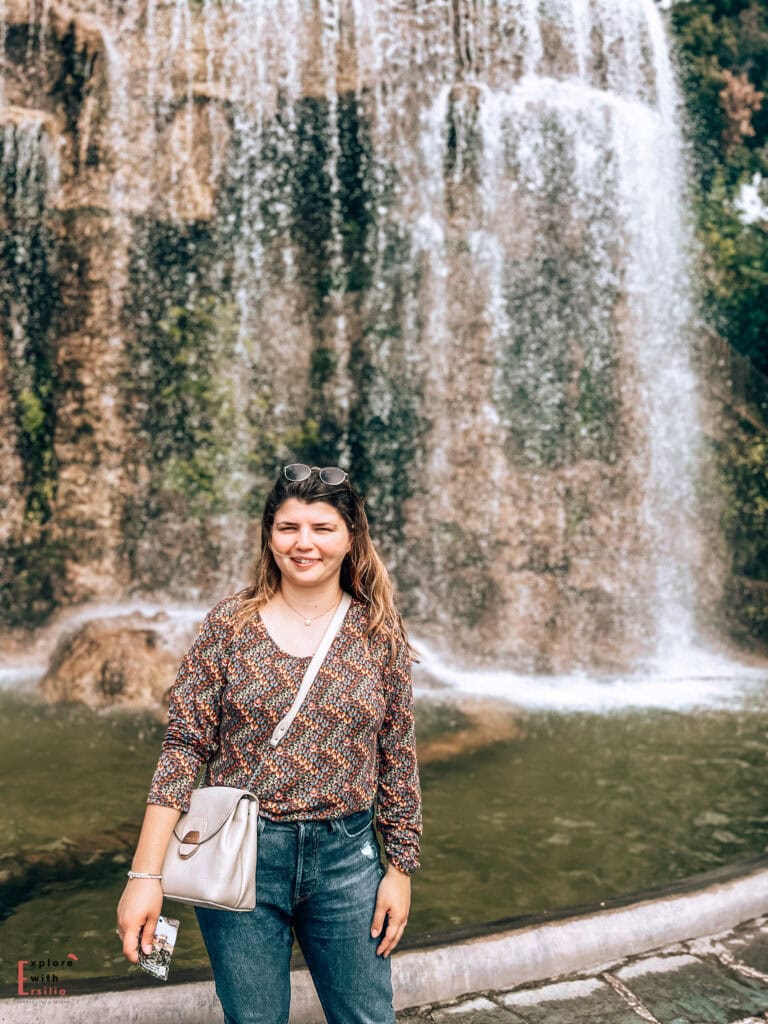
End your day with dinner at Acchiardo in the Old Town. This place serves the most authentic Niçois cuisine I’ve found. Finally, take one last evening stroll along the illuminated Promenade des Anglais. There’s something magical about seeing the lights reflect off the Mediterranean while the evening breeze carries the salt air – it’s the perfect way to end your first day in Nice.
Day 2: Monaco and Èze – A Tale of Two Worlds
Let’s talk about getting to these stunning destinations! You have several options, and I’ll break them down for you based on my experience. The most budget-friendly way is public transport – both train and bus connections are reliable and offer amazing coastal views along the way. If you prefer more flexibility, renting a car gives you the freedom to stop at viewpoints, though parking can be tricky (and expensive) in Monaco. For a stress-free experience, you could join a guided tour, but I personally prefer exploring at my own pace.
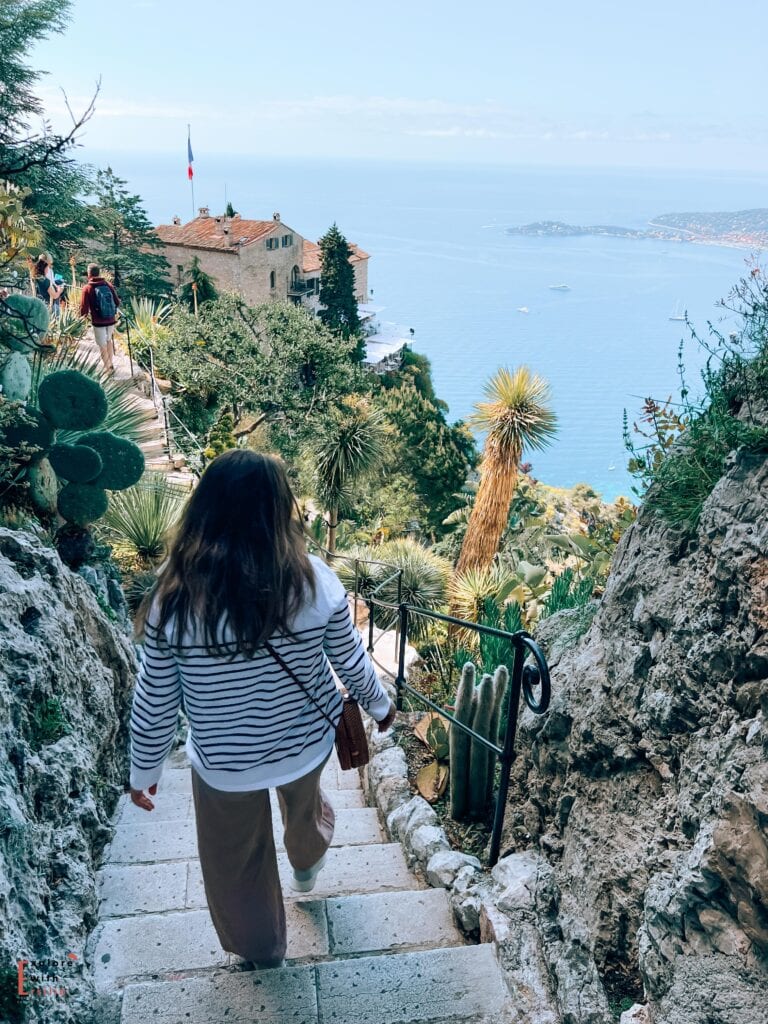
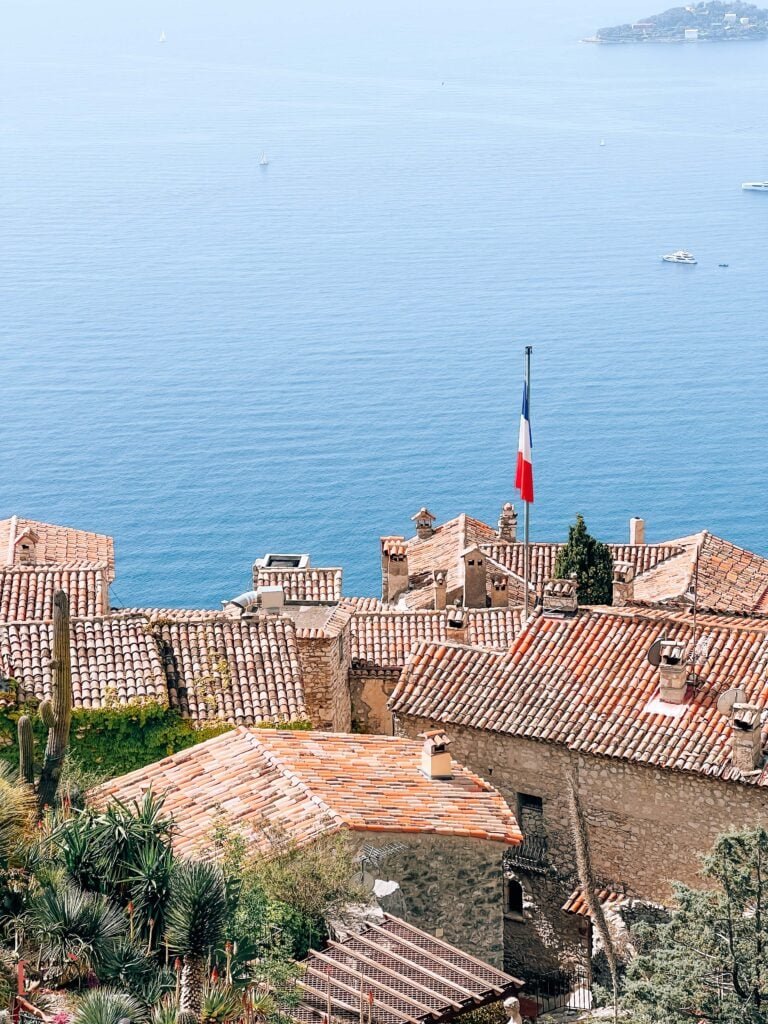
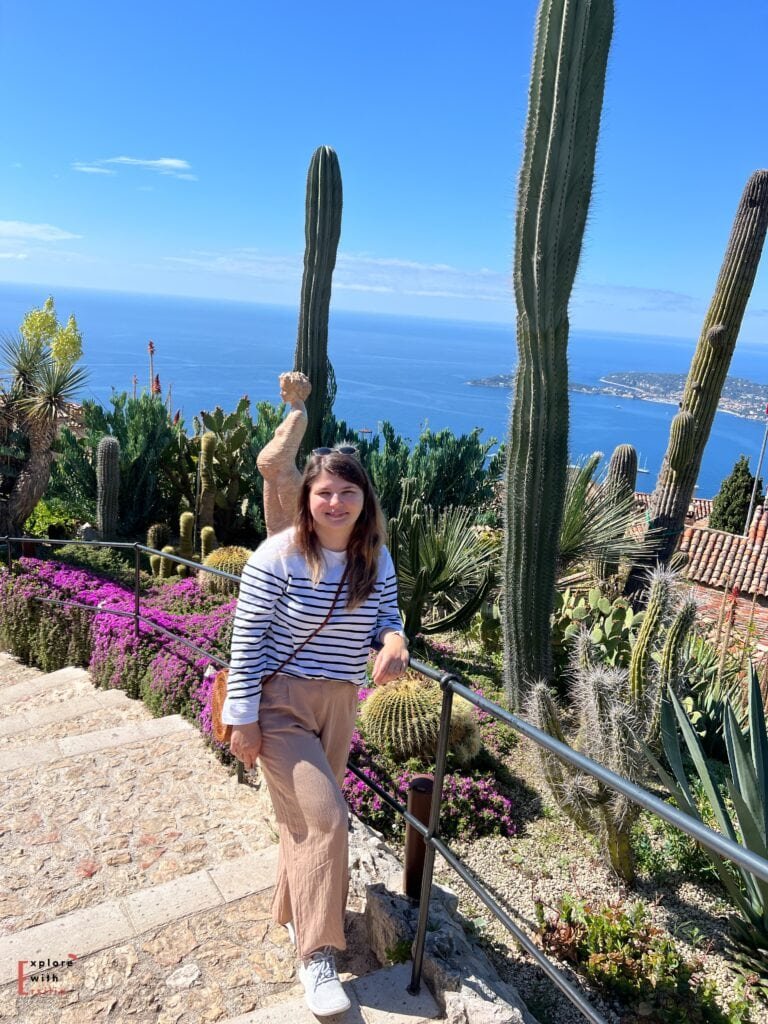
Morning: The Medieval Magic of Èze village
Èze village is one of those places that makes you feel like you’ve stepped into a fairytale, but timing is everything here! I cannot stress this enough – arrive early to beat the tour buses. Once those arrive, the narrow medieval streets can get incredibly crowded.
Here’s a money and time-saving tip that I wish I’d known earlier: while everyone queues at the main entrance to the exotic gardens, there’s a smarter way to get your tickets. Instead of joining the crowd, walk up to the garden entrance and look for the electronic ticket machines on the right side. The line here is usually much shorter, and you’ll get the same access! The gardens themselves are absolutely breathtaking, offering some of the most stunning views of the Mediterranean I’ve ever seen. Each turn reveals a new photo opportunity, with exotic plants framing the endless blue sea below.
While I didn’t get to visit the Fragonard perfume factory in Èze, I really wish I had! I did visit their factory in Grasse later in my trip, and it was such a fascinating experience. I ended up falling in love with their Belle de Nuit fragrance and couldn’t resist buying both the perfume and soap. The tours are free, and even if you don’t plan to buy anything, learning about the perfume-making process is incredibly interesting.
Afternoon: Embracing Monaco’s Glamour
Arriving in Monaco feels like stepping into another world entirely. This is not my gem, as I largely prefer old stone medieval villages, but it’s definetly a must see during your time on the French Riviera. Monaco is completly different from all the towns on the Côte d’Azur, with it’s impressive architecture and buildings that seem to grow on top of other buildings.
Some people fall in love with Monaco, some poeple hate it, which one will you be?
Make sure to time your visit to the Prince’s Palace perfectly for the changing of the guards at 11:55 AM – it’s quite a spectacle against the backdrop of this historic palace. I was amazed by how this tiny principality packs so much grandeur into such a small space.
The Monte Carlo Casino and its gardens are must-sees, even if you’re not planning to gamble. The architecture alone is worth the visit, and the meticulously maintained gardens make for perfect Instagram shots. Don’t miss the Oceanographic Museum either – the building itself is a stunning piece of baroque architecture perched dramatically over the sea, and the aquariums inside are absolutely incredible.
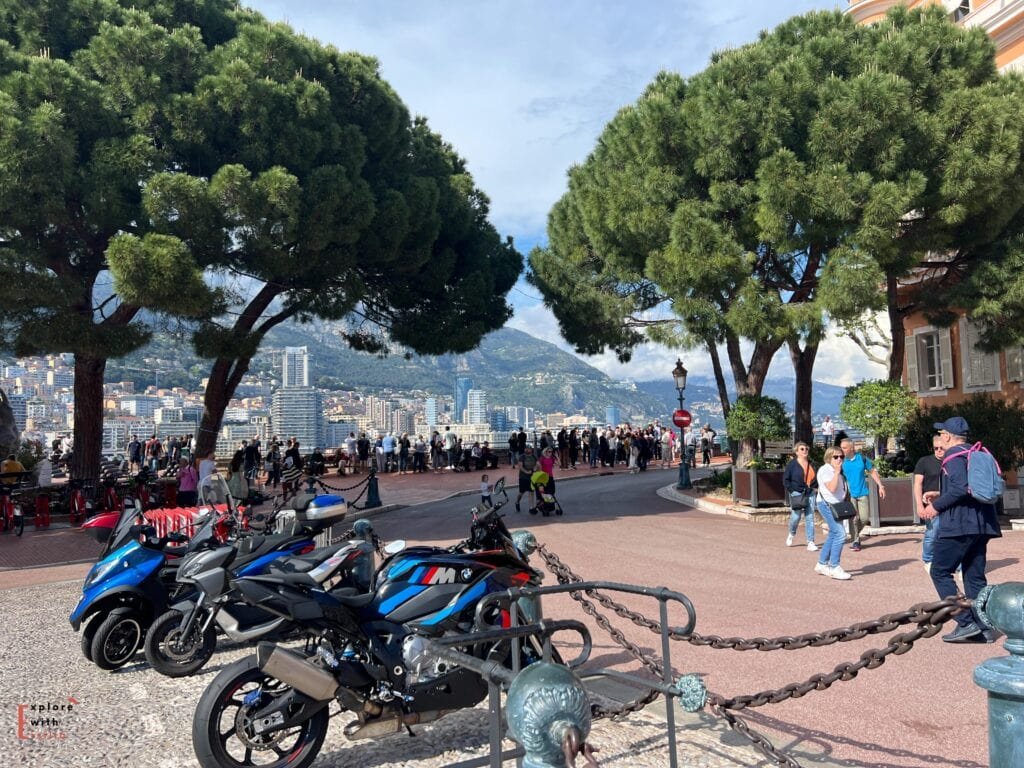
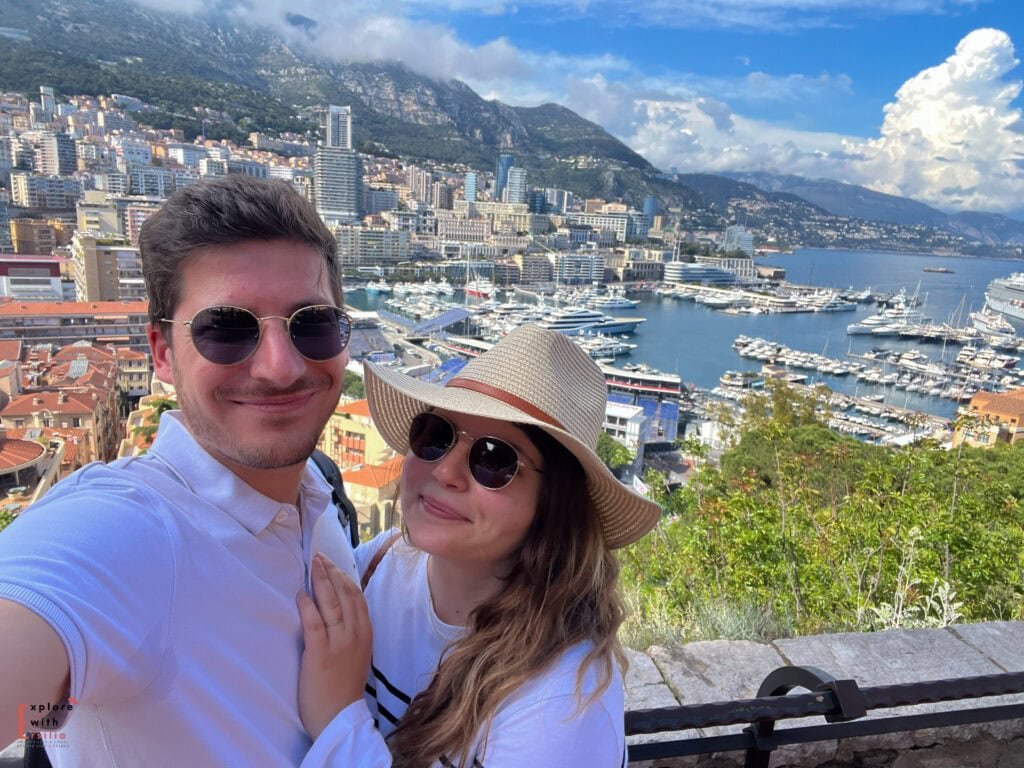
Evening: Monte Carlo After Dark
As the sun sets, Monaco transforms into something even more magical. Start your evening with dinner at Café de Paris – yes, it’s a bit pricey, but the people-watching here is unmatched. You’ll see everything from casual tourists to people dressed like they’re heading to a royal ball!
If you’re feeling lucky, try your hand at the Monte Carlo Casino – but remember to bring your passport! The interior is just as opulent as you’d imagine, even if you just go to admire the architecture. I spent more time admiring the décor than actually gambling!
End your evening with a peaceful stroll through the Japanese Gardens. It’s such a surprising find in Monaco, but these perfectly manicured gardens offer a serene escape from the glitz and glamour. The way they’re lit at night creates this magical atmosphere that’s perfect for a final evening walk.
Pro Tip: If you’re watching your budget in Monaco (and who isn’t?), pack a picnic to enjoy in the Japanese Gardens instead of dining at one of the pricey restaurants. The views are just as spectacular, and it’s a much more relaxed way to experience this luxurious destination.
Day 3: Antibes and Juan-les-Pins – Where Old World Charm Meets Beach Life
Morning: Discovering Antibes’ Historic Heart
Start your day early at the Provençal Market in Antibes’ Old Town. The morning bustle here gives you a real taste of local life on the French Riviera. The colors, scents, and sounds create this perfect Mediterranean atmosphere that I absolutely love.
Next up is the Picasso Museum in Château Grimaldi. Now, I’ll be honest – I’m not the biggest art enthusiast, but this place surprised me! Even if you’re like me and art isn’t your main interest, the building itself is worth exploring. The real highlight for me was stepping out onto the sea-facing terrace. The views are absolutely spectacular, and somehow knowing that Picasso once worked in this very space adds a special magic to the experience.
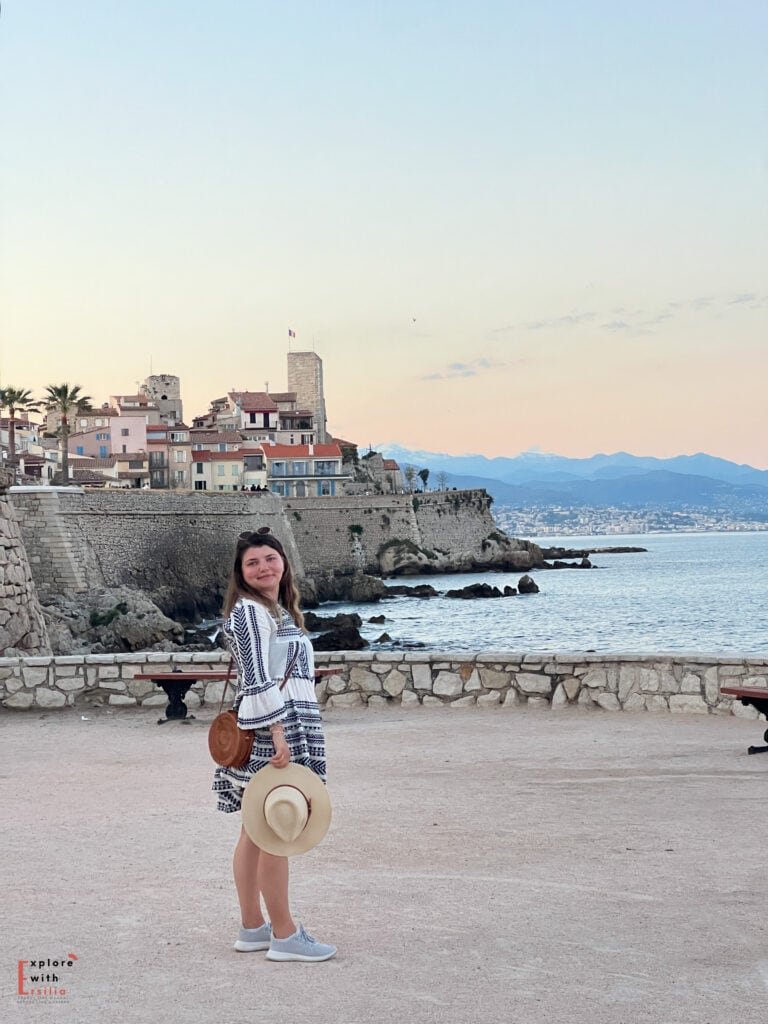
Don’t miss a stroll along Port Vauban, Europe’s largest private yacht harbor. It’s quite something to walk past these incredible super-yachts! I found myself imagining what it would be like to own one of these floating palaces. Even if luxury yachts aren’t your thing, the atmosphere here is uniquely French Riviera.
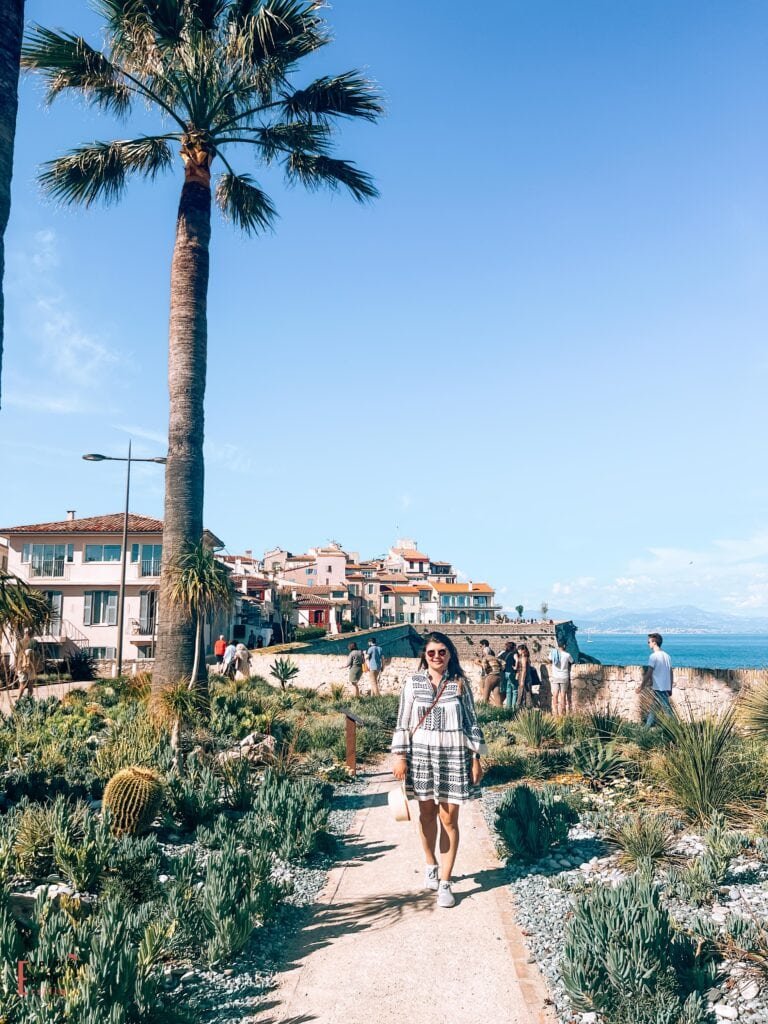
Afternoon: The Natural Beauty of Cap d’Antibes
The Sentier Littoral around Cap d’Antibes is one of my favorite coastal walks on the entire French Riviera. The path takes you past stunning villas and offers breathtaking views of the Mediterranean at every turn. Make sure to bring water and wear comfortable shoes – the path can be a bit rocky in places.
After your hike, treat yourself to a visit to the Villa Eilenroc gardens. These manicured grounds offer a glimpse into the glamorous life of the French Riviera’s golden age.
For a perfect afternoon relaxation, head to the hidden gem that is Plage de la Garoupe. This beach feels like a secret spot compared to some of the busier stretches of sand along the coast.
Evening: The Lively Spirit of Juan-les-Pins
Juan-les-Pins offers a completely different vibe from Antibes, and I love how these two atmospheres exist side by side. If you’re planning on enjoying one of the private beach clubs with their luxurious sunbeds, here’s a crucial tip from my experience: book in advance! Last May, we tried to rent sunbeds around 11 AM and found everything was already taken. In summer, it’s even more competitive, with prices ranging from 60-100 euros per person per day.
But here’s the good news – you absolutely don’t need to spend that kind of money to enjoy these beautiful beaches! We discovered that the public sections of the beach are just as lovely. Bring your own beach towel, and you’re all set. What I really appreciated was finding that the beach cabanas nearby sell reasonably priced sandwiches, coffee, and cold drinks. The quality was surprisingly good, and it made for a much more budget-friendly beach day.
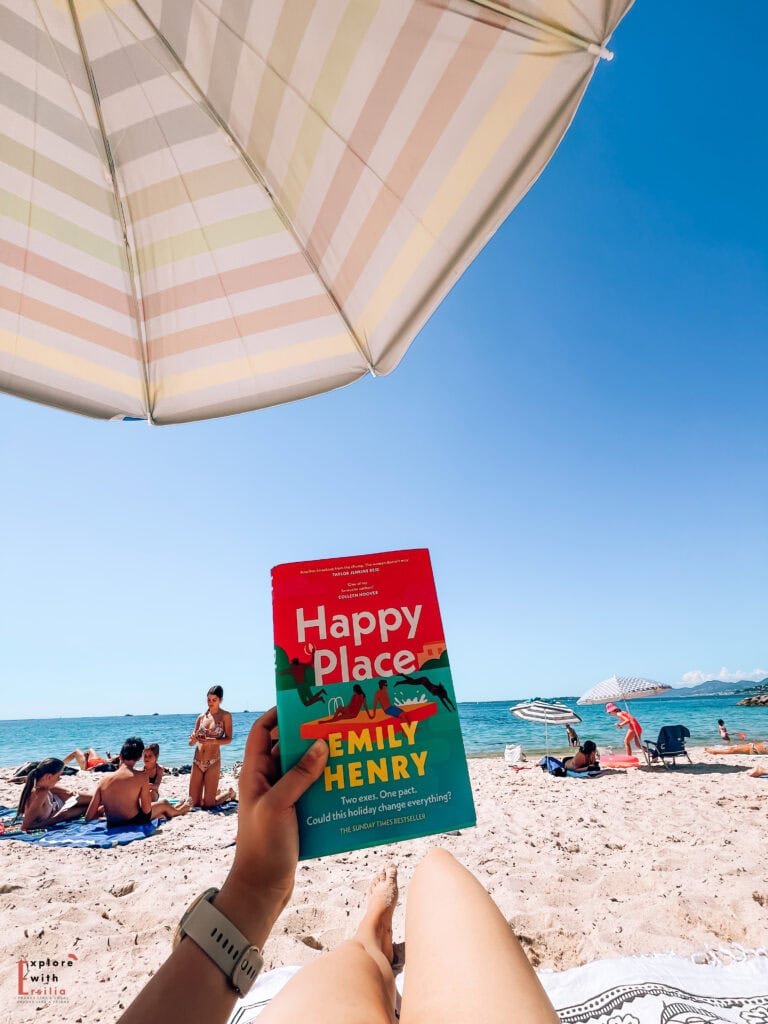
As evening approaches, take a walk along the pine-fringed promenade. The sunset views here are absolutely magical, with the silhouettes of pine trees framing the colorful sky. If you’re visiting during jazz festival season (10-20th July in 2025), you’re in for a treat – the legendary jazz bars come alive with music that seems to float through the evening air.
For dinner, let me share a great place I found: Restaurant Chez Mô (Albert 1er) et Poissonnerie serves some of the best seafood I’ve found in the area. But here’s another crucial tip – make a reservation!! The best restaurants here fill up quickly, especially during peak season. The fruits de mer here are absolutely worth planning ahead for.
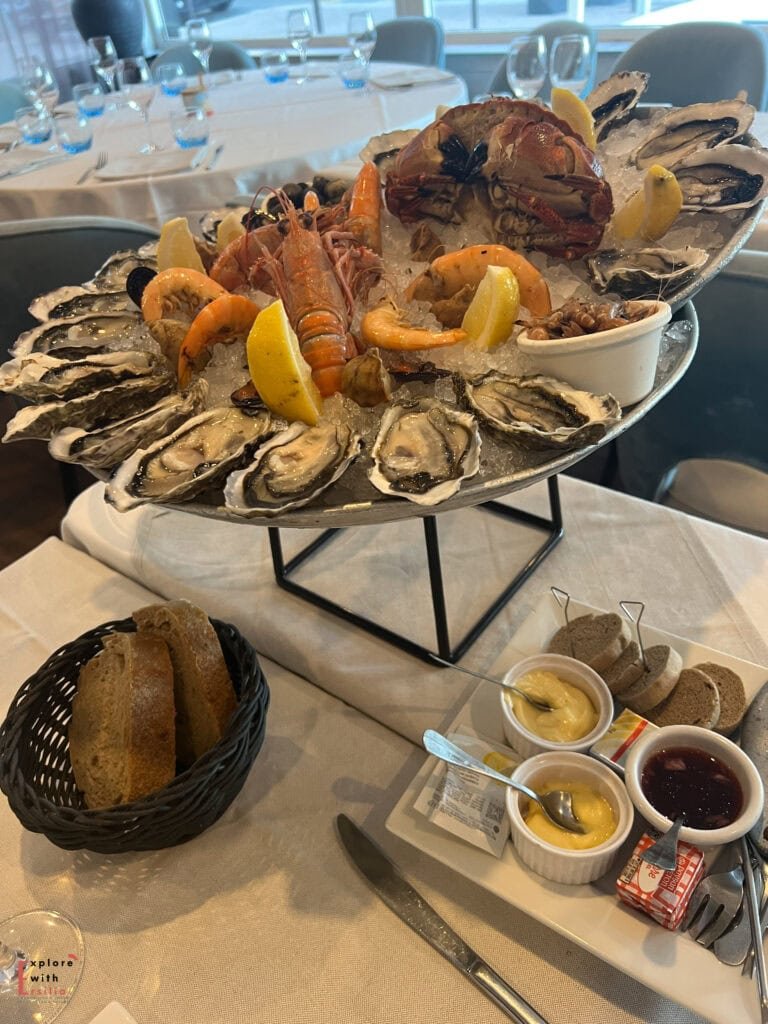
Pro Tip: If you’re spending the whole day between Antibes and Juan-les-Pins, consider having a relaxed lunch in Antibes’ old town before heading to Juan-les-Pins for your beach afternoon. The restaurants in the old town often offer better value than the beachfront establishments, and the atmosphere in those narrow medieval streets is unbeatable.
Day 4: Medieval Villages and Perfume Capital – Saint-Paul-de-Vence, Vence, and Grasse
Let’s start with something crucial: how to get to these charming villages without a car. The journey is part of the adventure, and I’ll share all my transportation tips to make your day smooth and stress-free.
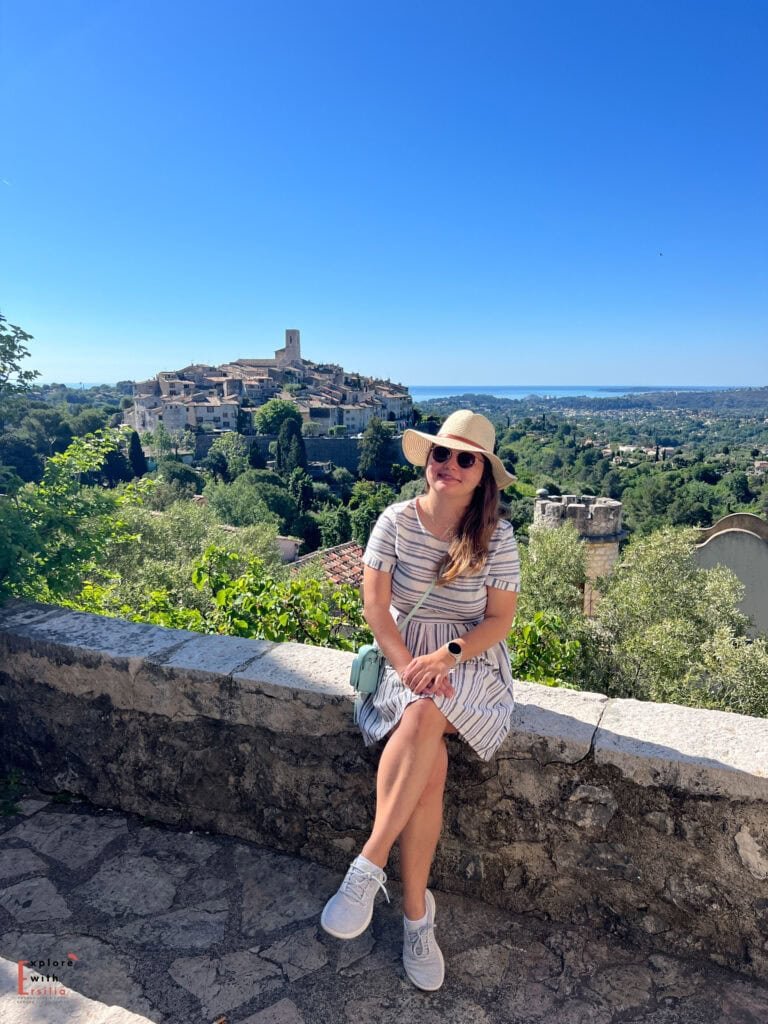
Getting There: Your Transportation Guide
To reach Saint-Paul-de-Vence from Nice, take Bus 400 from Avenue de Verdun. Look for the stop about 200 meters up from Le Meridien Hotel on the Promenade des Anglais. Here’s an important tip: you can’t use your multi-ticket on this bus – it’s €1.50 each way, paid directly to the driver. During summer, be prepared to stand for the 50-minute journey as it gets quite packed!
There are two key stops you need to know about: Fondation Maeght and St Paul Village. Here’s my secret shortcut: if you’re heading to the Fondation Maeght, get off at its namesake stop and look for an unmarked track heading into the woods at the first car park on your left. This little-known path will save you several minutes of walking and will give you incredible views of Saint-Paul-de-Vence on the hilltop! This is the only place you can have that view.
If you’re going straight to the village, continue to the St Paul Village stop. But here’s a crucial tip: when you later want to visit the Fondation, don’t take the steep road marked “Fondation Maeght” – it’s a lengthy detour meant for cars. Instead, walk back down to the Fondation Maeght bus stop and use my woodland shortcut. Your legs will thank me, especially on a hot day!
Morning: Saint-Paul-de-Vence’s Timeless Beauty
Arriving early in Saint-Paul-de-Vence is absolutely worth it. As a fellow lover of historical details, I was in heaven here! The cobblestone streets hold so many treasures – ancient doorways, stone houses where plants peek through centuries-old cracks, and intimate squares that feel frozen in time. But what absolutely captivated me were the hand-painted letterboxes. I’ve never seen anything like them anywhere else on the French Riviera – each one tells its own unique story of the village and its residents. I found myself photographing nearly every one!
The Fondation Maeght is a must-visit for art enthusiasts, and even if you’re not typically drawn to modern art, the building itself and its setting are worth experiencing.
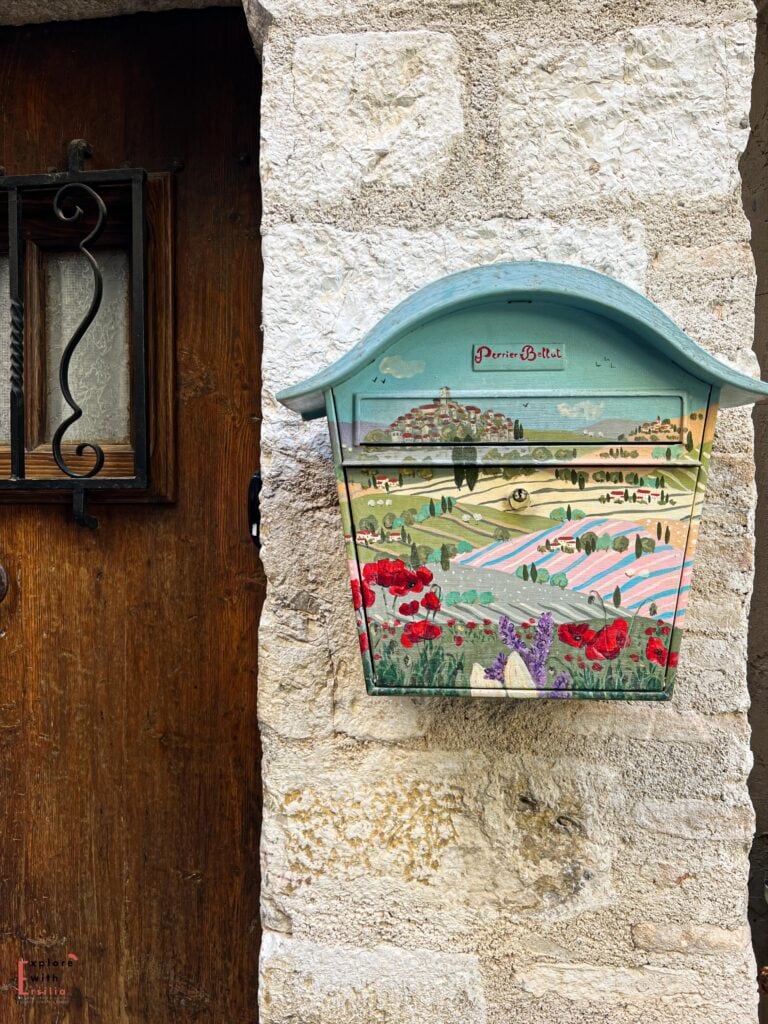
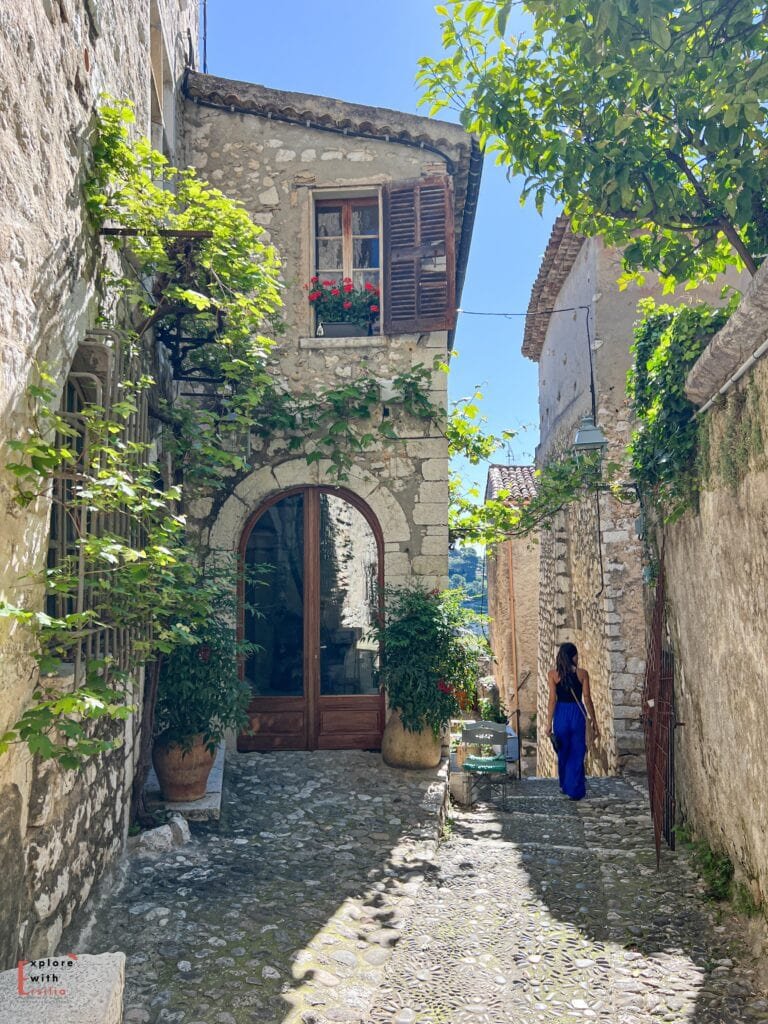
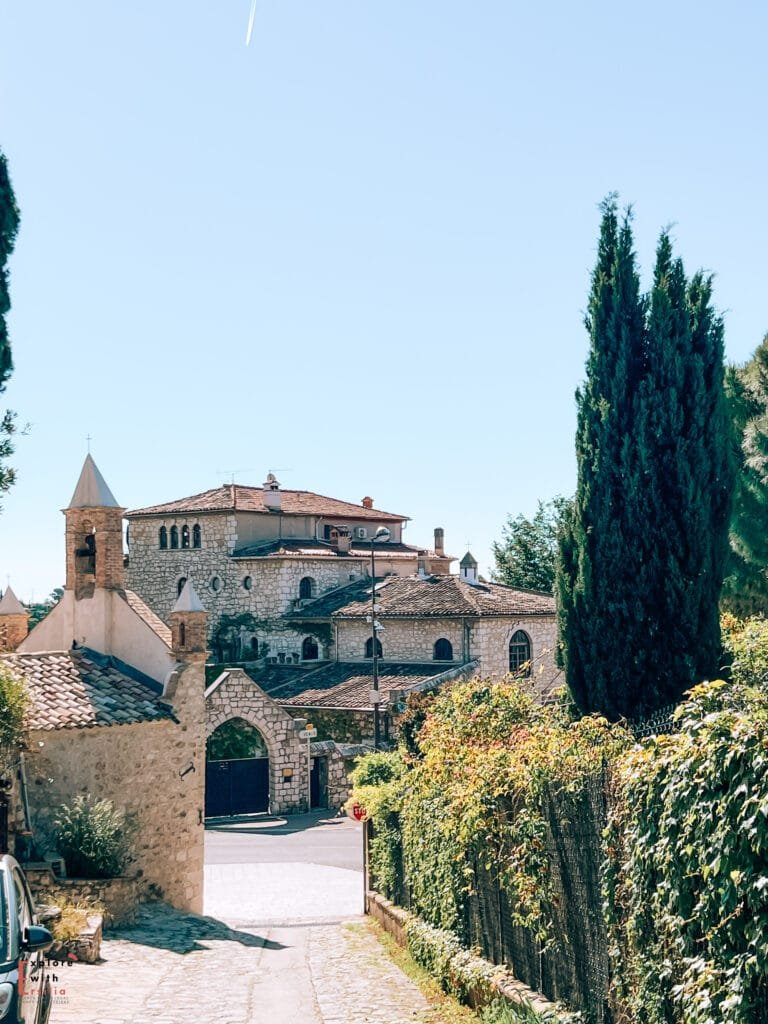
Lunch and Early Afternoon: Vence’s Hidden Charms
In Vence, the Chapelle du Rosaire is a masterpiece that showcases Matisse’s genius in an unexpected way. The historic old town feels more lived-in and authentic than its famous neighbor, with artisan workshops where you can watch craftspeople at work. I loved taking a coffee break at Place du Grand Jardin, watching local life unfold around me.
If you’re traveling by car, I have a special recommendation: squeeze in a visit to Tourrettes-sur-Loup, just a few kilometers from Vence. I absolutely fell in love with this village last year when I stayed there. It’s less touristy than Saint-Paul-de-Vence but equally charming.
Afternoon: Grasse – The World’s Perfume Capital
Getting to Grasse requires some planning. If you’re coming directly from Nice, here’s my top tip: forget the train and take Bus 650 instead. The train station in Grasse sits at the bottom of a steep hill, far from everything interesting. Catch the 650 from either Parc Phoenix (my recommendation, as it’s right by tram line 2) or the Airport/Promenade stop. The journey ends at Grasse Gare Routière, right next to the tourist office – perfect for picking up a map!
If you’re continuing from Vence, take the bus from Foch Lycee Matisse to Ossola. The journey takes about an hour, but the scenery makes it worthwhile.
Once in Grasse, you’re in for a treat! The perfume factory (Fragonard house) tours are fascinating – you’ll discover the history of perfume and how local flowers become the luxury fragrances sold worldwide. But don’t just focus on perfume; take time to wander the charming streets, now famous for their pink umbrella canopies. These create the perfect shade for enjoying a coffee at one of the terraces below.
Make sure to visit the Musée Provençal du Costume et du Bijou – it’s a quick but fascinating look at French Riviera fashion through the ages. I was surprised by how much I enjoyed this little museum!
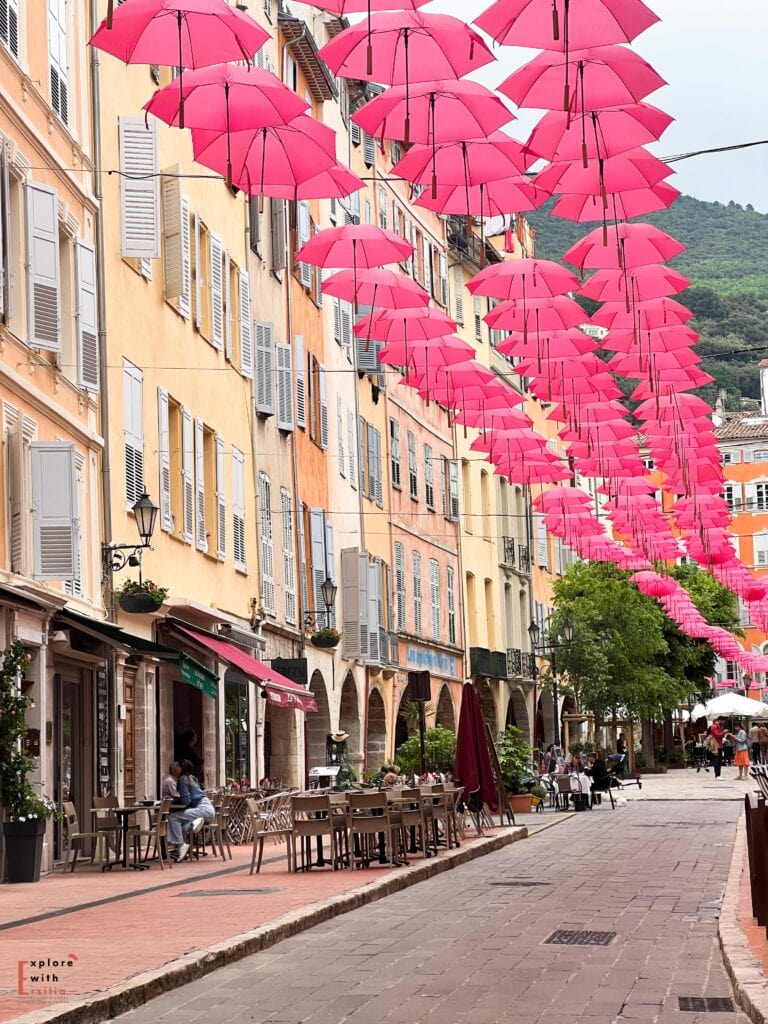
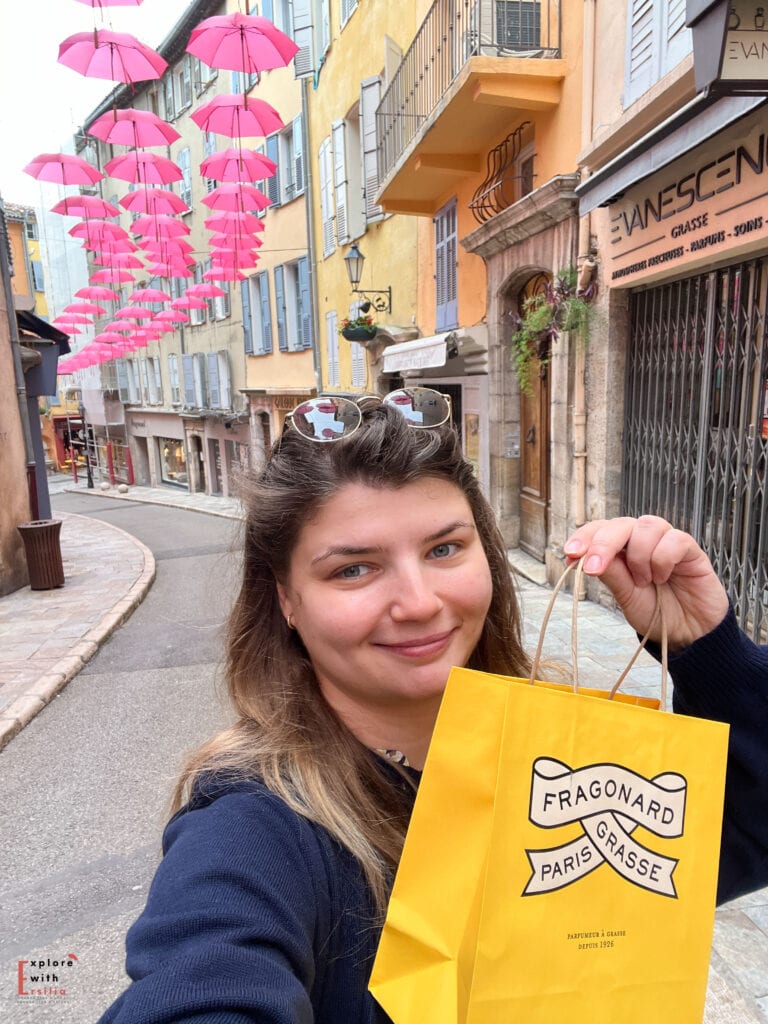
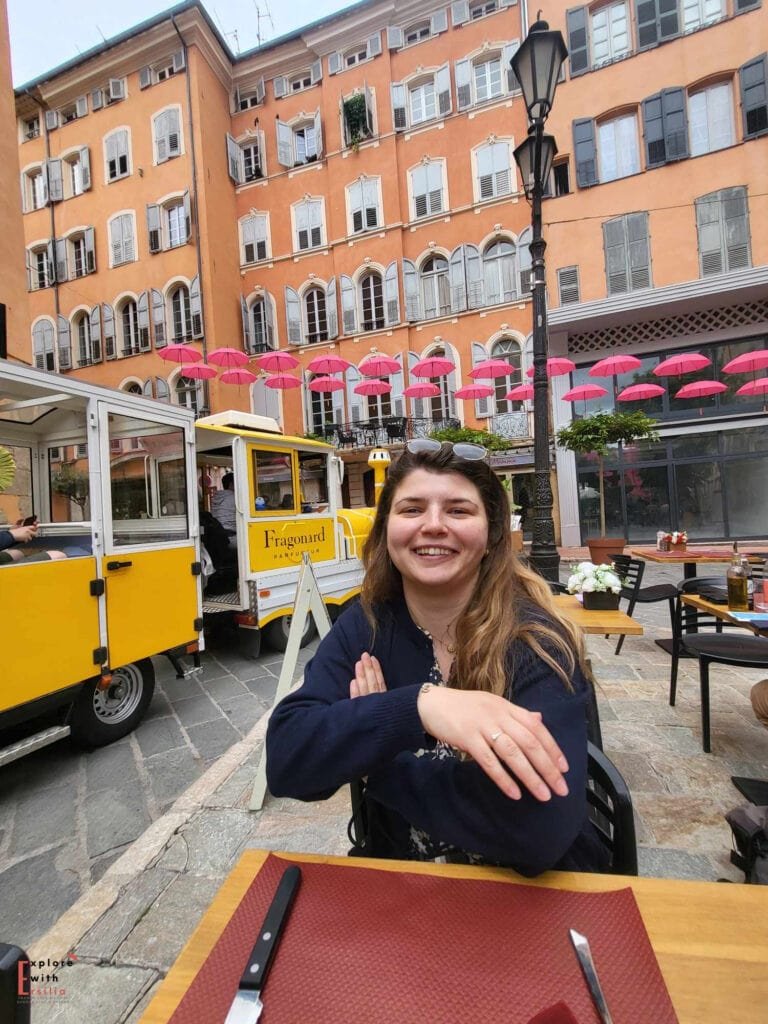
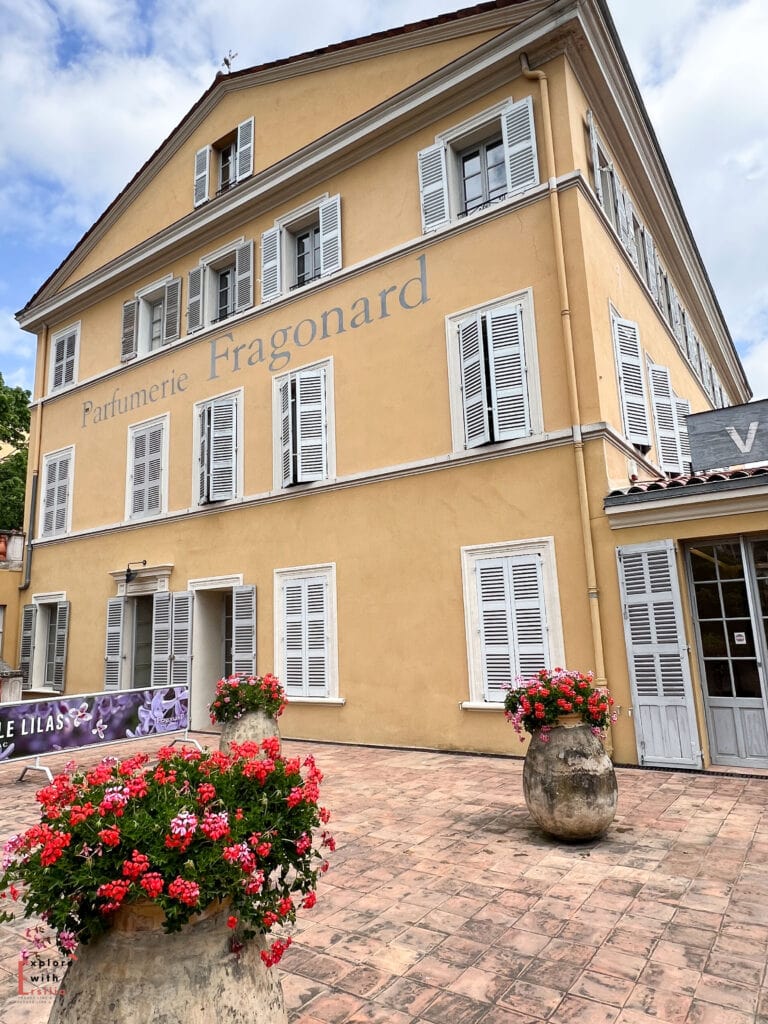
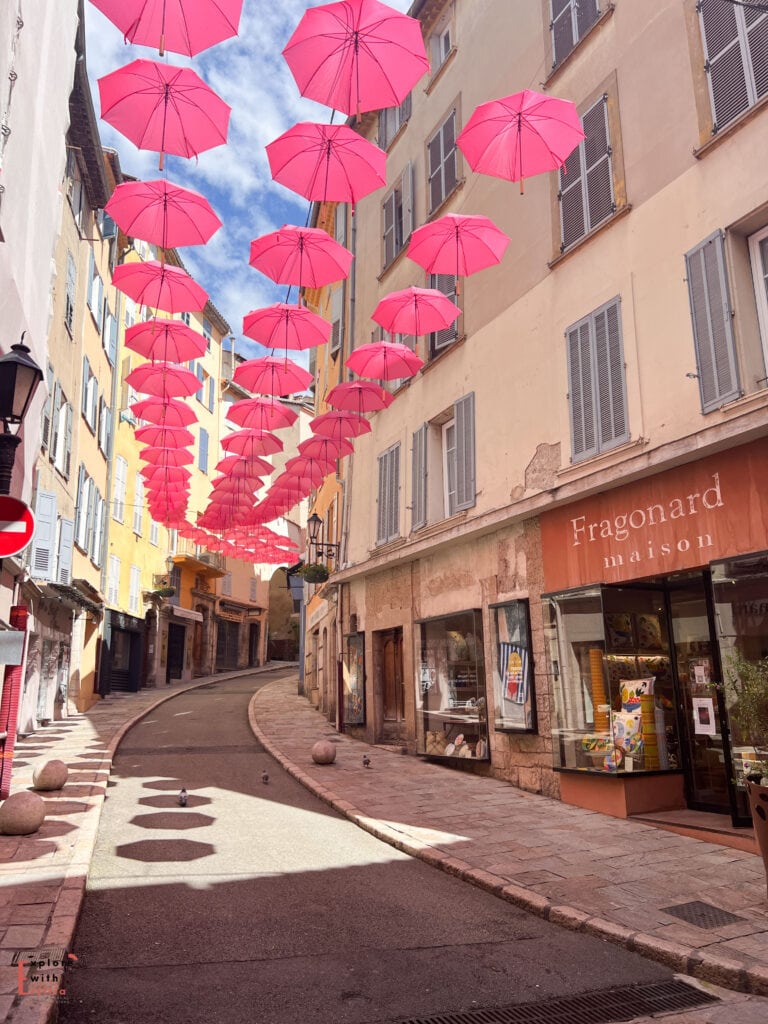
Evening: Back to Nice in Style
End your day back in Nice with a sophisticated evening that perfectly contrasts with your day of village exploration. Head to the rooftop bar at Le Meridien for a sunset aperitif with stunning views. Follow this with dinner at La Petite Maison, a true local institution. Finally, take a romantic stroll through Place Massena, beautiful in its evening illumination.
Pro Tip: If you’re visiting the perfume factories, go earlier in the day when your sense of smell is sharper. By the end of a long day of sniffing, it becomes harder to distinguish between different scents
Day 5: Villefranche-sur-Mer and Saint-Jean-Cap-Ferrat – A Perfect French Riviera Finale
Morning: The Charm of Villefranche-sur-Mer
Start your final day in one of the most picturesque spots on the French Riviera – Villefranche-sur-Mer. The moment you enter the Old Town, you’ll understand why artists throughout history have been drawn to this place. The colors here are simply incredible – ochre and terracotta buildings cascade down to a harbor that sparkles in shades of blue I didn’t even know existed.
Take time to explore the winding streets of the old town. Unlike some of the more famous coastal towns, Villefranche-sur-Mer maintains an authentic, lived-in feel that I absolutely love. Don’t miss the 16th-century Chapelle Saint-Pierre, decorated by Jean Cocteau. The artist’s distinctive style transforms this small chapel into something truly unique.
The waterfront promenade offers some of the most stunning bay views on the entire coast. I recommend taking a slow walk here, perhaps with a morning coffee in hand, watching the fishing boats coming and going in the harbor.
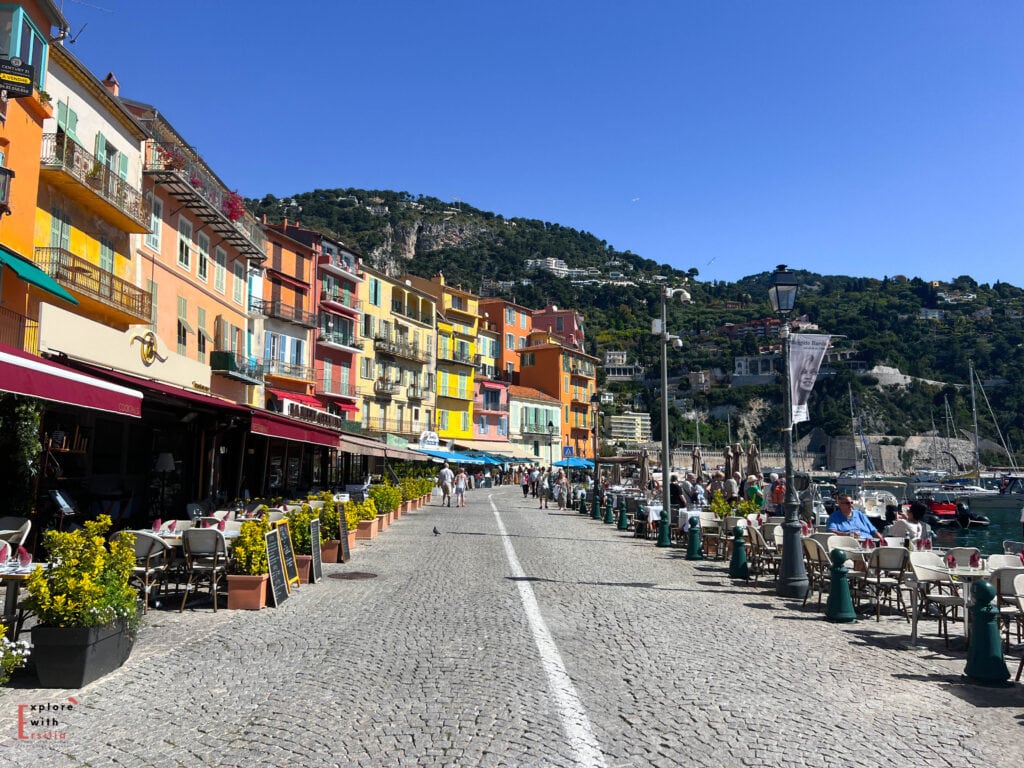
Afternoon: The Elegance of Saint-Jean-Cap-Ferrat
The Villa Ephrussi de Rothschild stands as the star of Saint-Jean-Cap-Ferrat. My visit during rose season left me speechless – walking through gardens where delicate roses echo the soft pink of the villa walls created an almost dreamlike experience. The whole estate feels like stepping into an impressionist painting come to life.
Here’s an insider tip you won’t want to miss: time your visit around the musical fountain shows that happen every 15-20 minutes. Check the schedule at the entrance or in the gardens – trust me, you don’t want to miss this spectacular display!
While the villa’s interior is impressive, the gardens are the real showstoppers. They’re organized by theme and region – you’ll travel from a Mediterranean garden to a Japanese one in just a few steps. I recommend exploring the villa first, then taking your time to wander through all nine gardens.
If you’re up for a special treat, consider having lunch at the villa’s Salon de thé de Beatrice. This isn’t just a meal – it’s a journey back to the French Riviera’s golden age. The room itself is stunning, and while it’s not budget-friendly, it’s surprisingly accessible with set menus at €24 or €31, including a main dish and dessert. Just remember to book in advance! The restaurant is open daily from 11:00 to 17:30 (18:30 in July/August), with lunch served between 12:00 and 15:00.
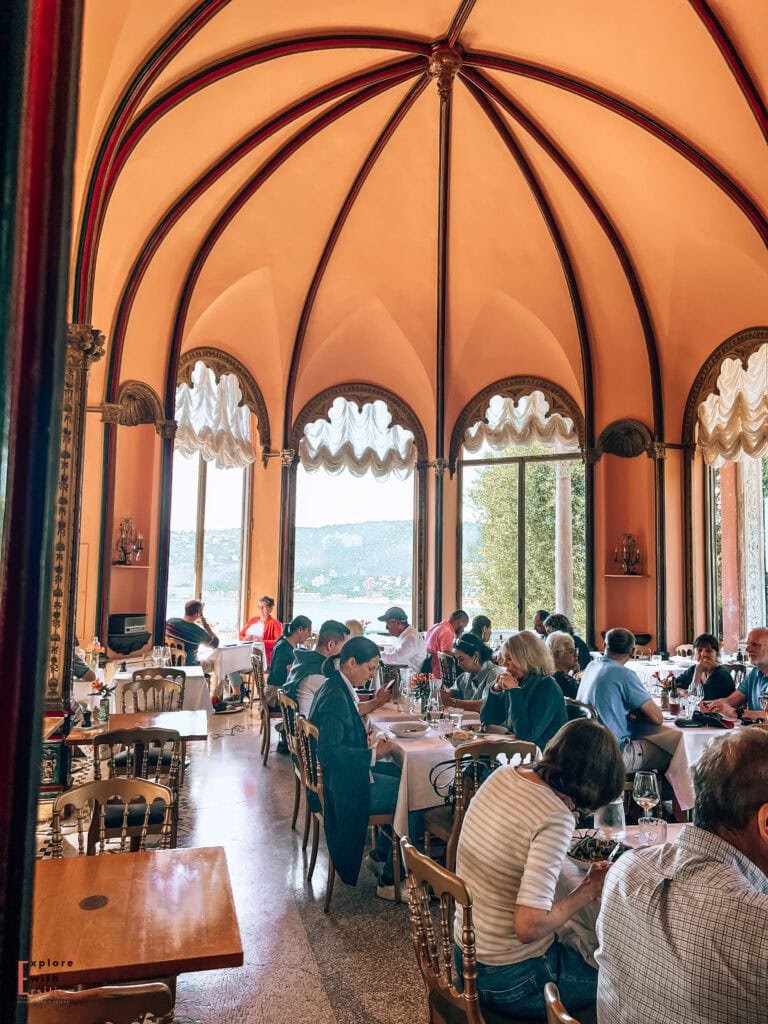
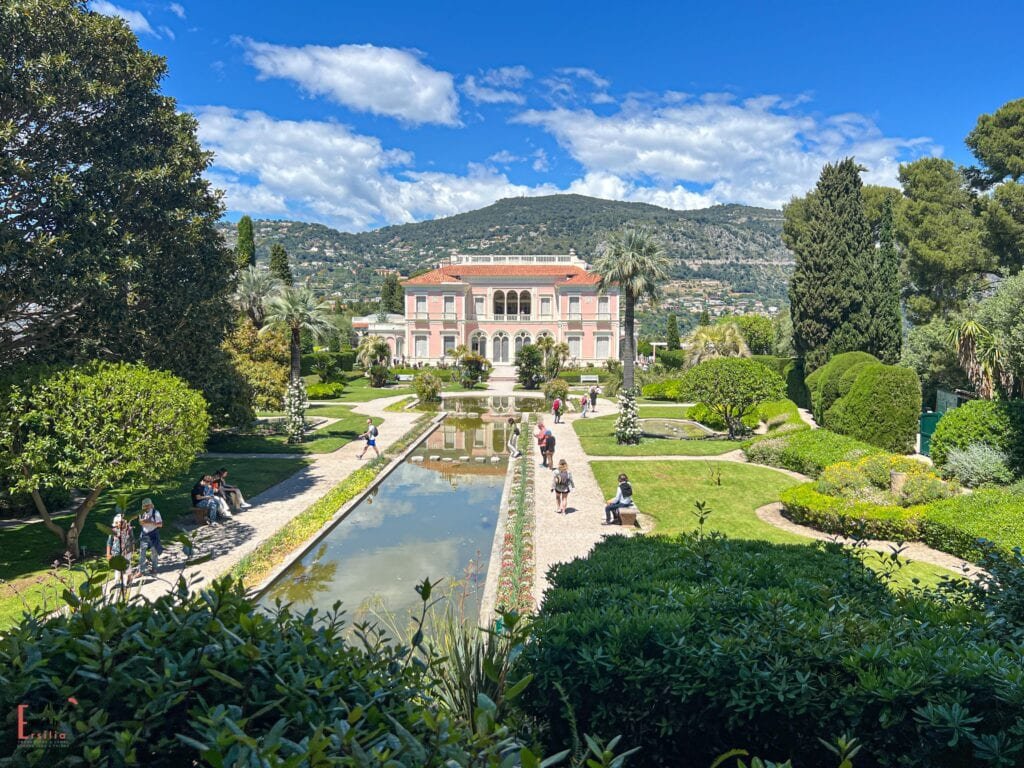
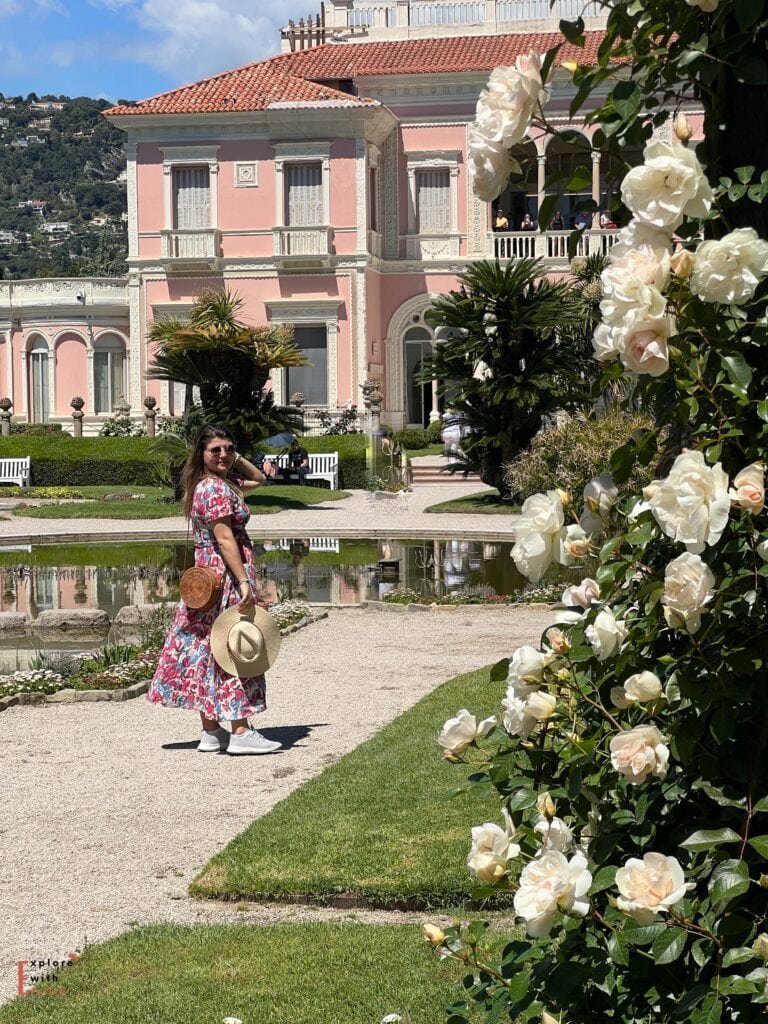
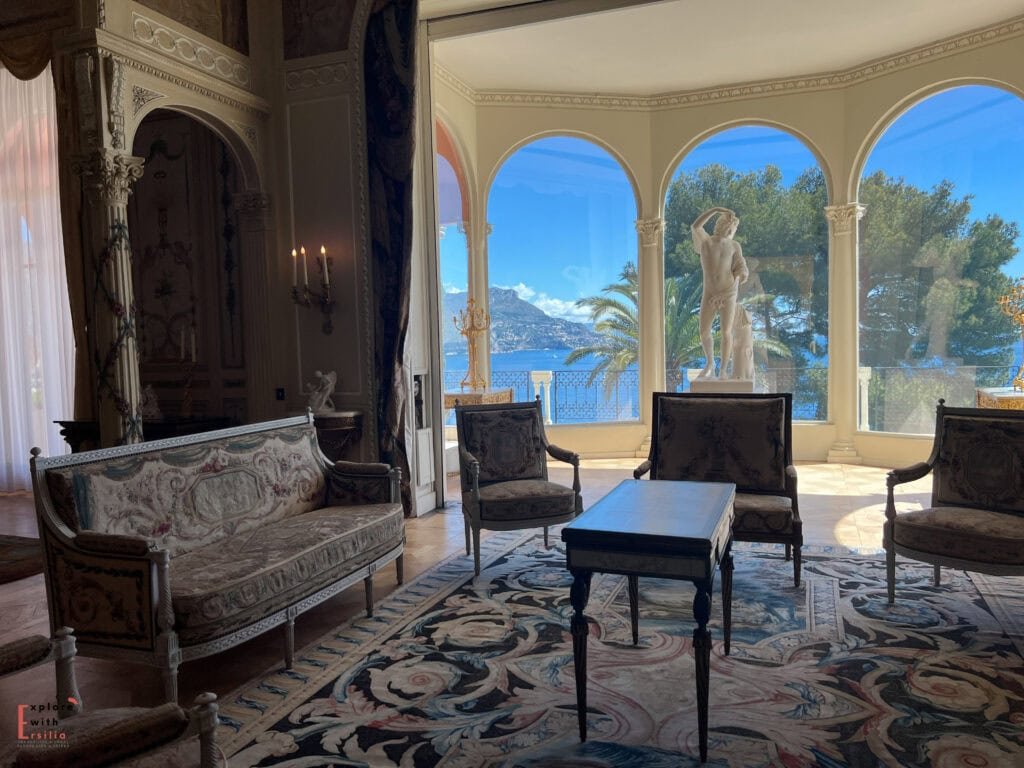
After lunch, it’s time for one of my favorite walks on the entire French Riviera – the Sentier Littoral coastal path. Some say it’s a nice walk (and it definetly starts like one!), other says it’s more like a coastal hike. I guess it depends on your level of fitness. Either way, I would say everyone can do it, just bring water with you during the hot days !
Starting from the charming port, this path takes you on a two-hour journey past a majestic lighthouse and eventually to the iconic beach of Plage des Fossettes. Fair warning: what should be a two-hour walk took me much longer because I couldn’t stop taking photos! The Mediterranean views and the blue water here are simply incredible.
The path leads you through the port of Saint-Jean-Cap-Ferrat, which is perfect for a break. Whether you want a proper meal at one of the terrace restaurants or just an ice cream in the park facing the sea, you’re in for a treat. They have this amazing wooden structure where you can sit and soak in the views completely free of charge – it’s one of those perfect spots to just pause and take in the beauty of the French Riviera.
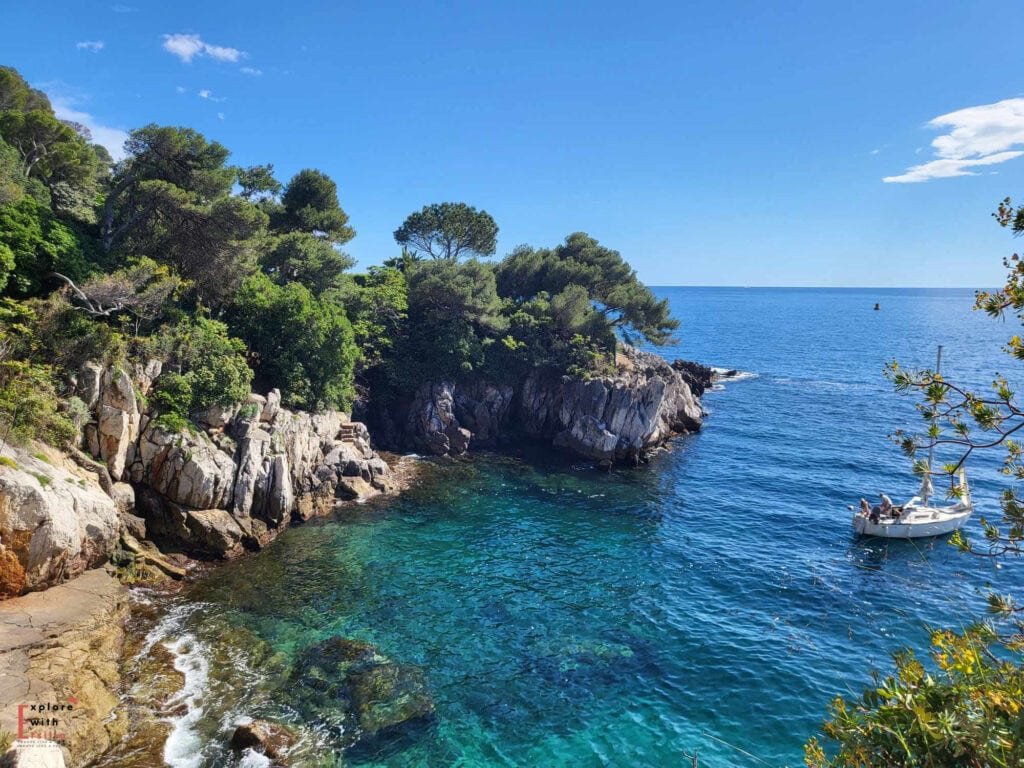
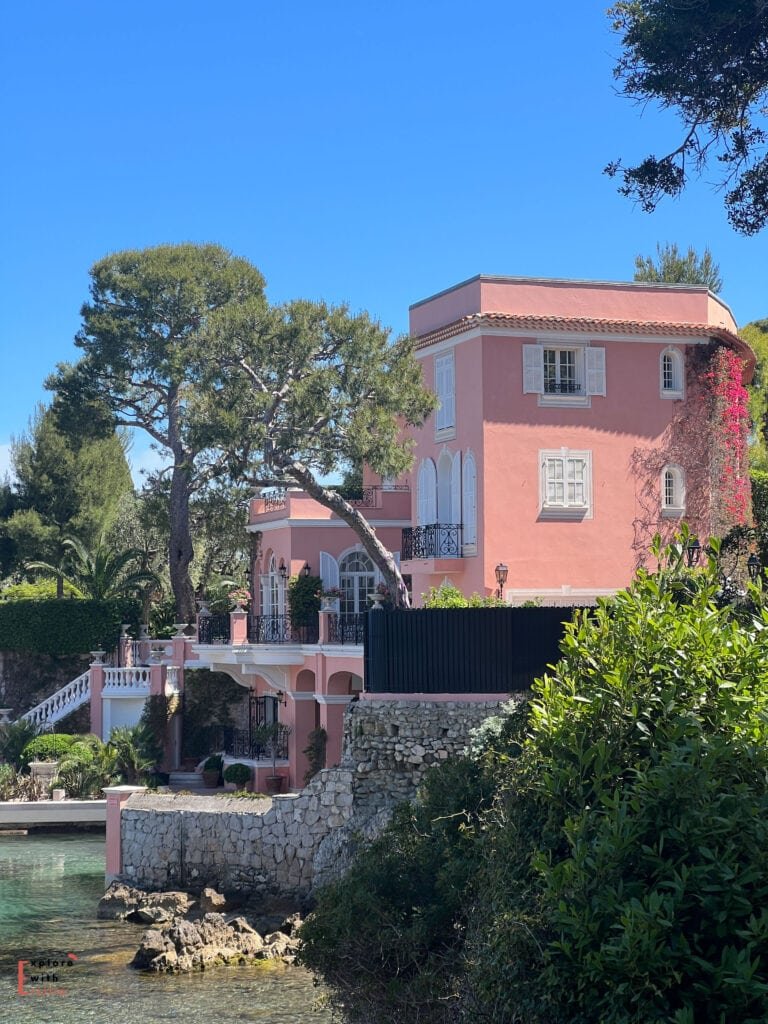
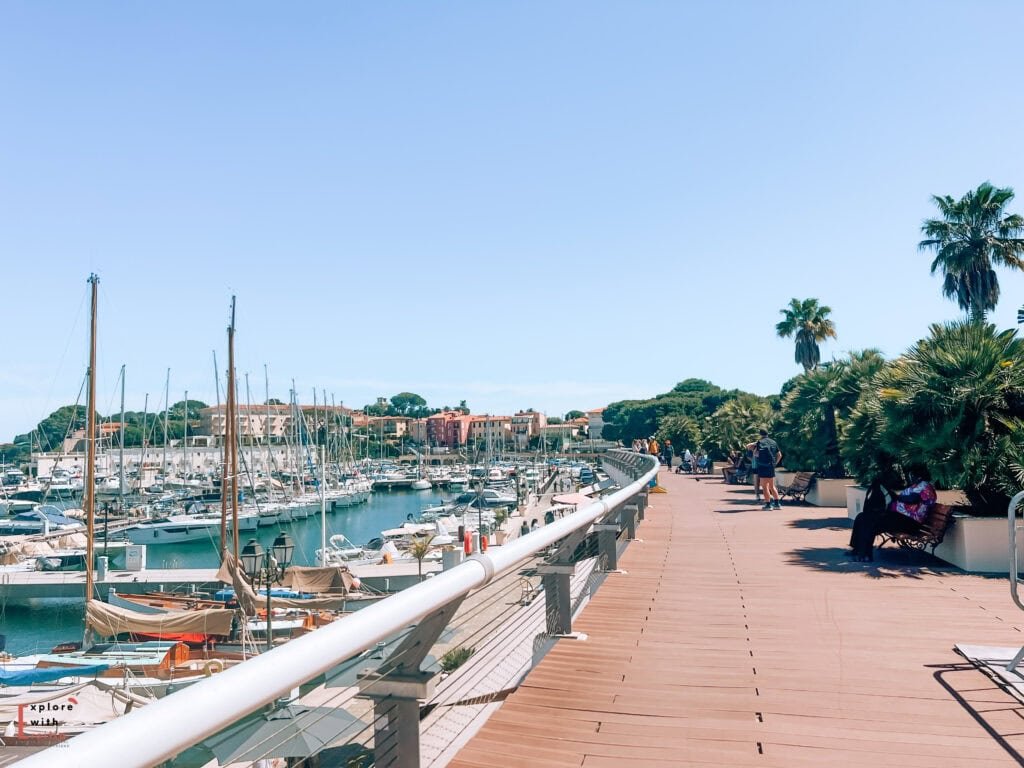
Evening: A Sunset Farewell
End your French Riviera adventure back in Villefranche-sur-Mer for dinner. The restaurants along the waterfront offer the perfect setting for a farewell meal. As the sun sets, take one final walk along the beach, watching the coastline gradually illuminate. The way the lights reflect on the water creates an absolutely magical atmosphere – it’s the perfect way to say goodbye to this stunning corner of the world.
Pro Tip: If you’re visiting Villa Ephrussi on a warm day, plan your garden tour for early morning or late afternoon. The gardens have less shade than you might expect, and you’ll want to be comfortable while you explore their beauty.
Essential Tips for Your French Riviera Adventure
Getting Around the Coast
The French Riviera’s transportation system makes exploring a breeze. The coastal train line became my best friend during my visits – it’s reliable, affordable, and offers stunning sea views along the way. Trains connect all major coastal towns, running frequently throughout the day.
While public transport works perfectly for coastal towns, having a car opens up a whole new world of possibilities. Villages like Tourrettes-sur-Loup, Gourdon, and even Grasse become much more accessible. I particularly appreciated having a car when visiting Grasse – the freedom to explore the surrounding lavender fields and perfume routes made the experience so much richer.
For bus travel, download the Lignes d’Azur app before your trip. It’s a lifesaver for checking schedules and planning routes. Plus, bus tickets are incredibly affordable – often just €1.50 per journey!
Smart Saving Strategies
The French Riviera doesn’t have to break the bank. The French Riviera Pass quickly pays for itself if you’re planning to visit several museums. I saved nearly €50 in museum entries during my spring visit using this pass.
Speaking of spring – traveling during shoulder season (April-May or September-October) can cut your accommodation costs by up to half. The weather is still beautiful, and you’ll share the beaches with locals instead of tourist crowds.
Food can be a major expense, but there are ways to enjoy the region’s incredible cuisine on a budget. Most restaurants offer a “menu du jour” at lunch – the same quality as dinner but at significantly lower prices. My favorite money-saving ritual became joining the locals for “apéro” (happy hour) around 6 PM. Many bars offer discounted drinks and complimentary snacks during this time.
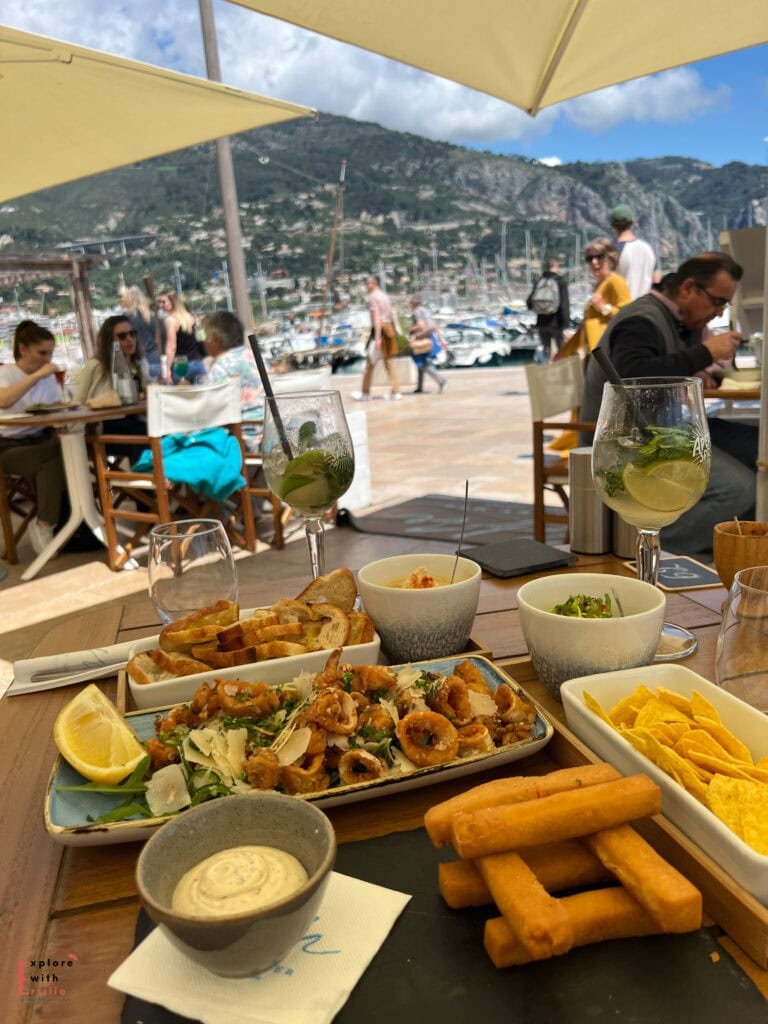
The Perfect Time to Visit
Spring on the French Riviera stole my heart completely. The period from April to June offers perfect temperatures, blooming flowers, and reasonable prices. September and October mirror these ideal conditions, with the added bonus of warm sea temperatures for swimming.
August deserves a special warning – it’s when prices skyrocket and crowds reach their peak. Most French people take their vacation this month, making accommodations scarce and expensive. Plus, the heat can be intense, often making midday sightseeing uncomfortable.
Packing Essentials
After several trips to the region, I’ve perfected my packing list. Comfortable walking shoes are non-negotiable – those charming cobblestone streets quickly lose their charm if your feet hurt! I learned this lesson the hard way during my first visit to Saint-Paul-de-Vence.
The French Riviera maintains an elegantly casual dress code. Pack smart-casual attire for evening dining – you’ll want to dress up a bit for restaurants, especially in Monaco or Antibes. During the day, the vibe is relaxed but stylish.
Don’t forget your swimming gear, even in spring or fall. Those spontaneous dips in the Mediterranean are part of the magic here. I went swimming well into October during my last visit!
Lastly, bring your best camera – whether it’s a DSLR or just your phone. The light here is spectacular, especially during golden hour. Some of my favorite photos were taken during early morning walks along the coastal paths when the sun painted everything in soft, warm tones.
Pro Tip: Pack a light scarf or shawl – it’s perfect for those sea-breeze evenings and helps you blend in with the locals who consider them a year-round accessory.
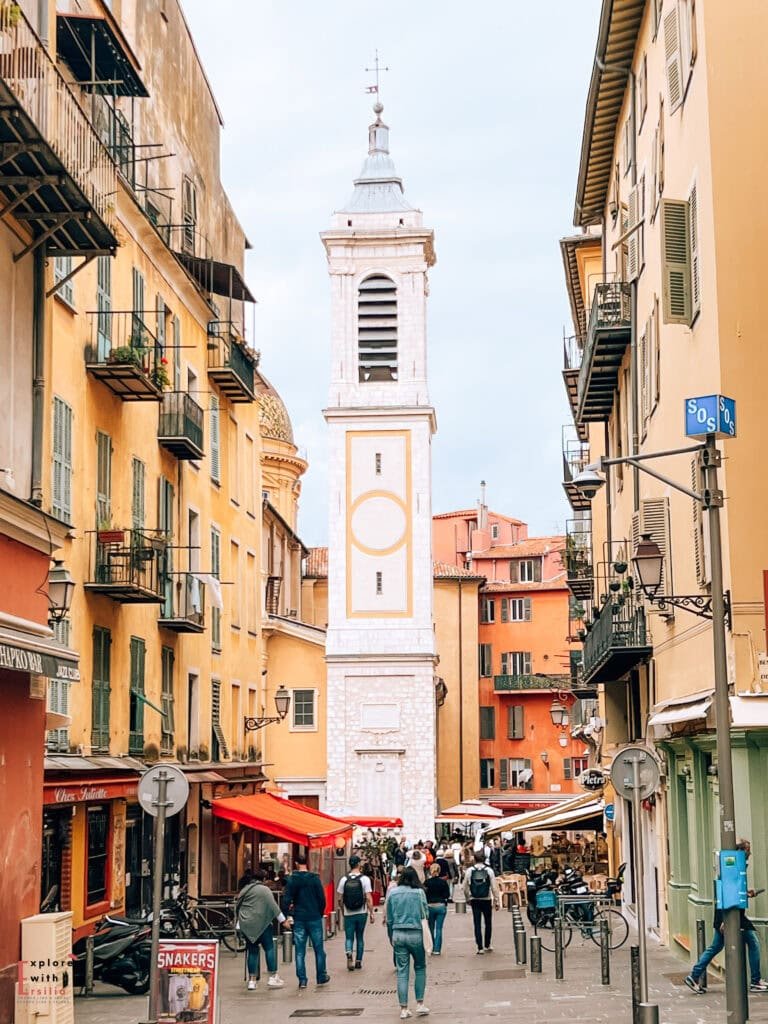
Final Thoughts on This 5 day French Riviera Adventure
When I first dreamed of visiting the French Riviera, it seemed like a destination reserved for movie stars and millionaires. But after experiencing it firsthand, I discovered a different side of this legendary coastline – one that’s accessible, welcoming, and full of possibilities for every type of traveler.
This 5-day itinerary gives you a perfect taste of what makes the Côte d’Azur special. From the vibrant markets of Nice to the medieval charm of Èze, from the glitz of Monaco to the artistic soul of Saint-Paul-de-Vence, each day reveals a new facet of this diverse region. The mix of cultural experiences, natural beauty, and historical discoveries creates memories that will stay with you long after your trip ends.
What I love most about this route is its flexibility. You can adapt it based on your interests and energy levels – spend more time at the beaches if you’re craving relaxation, or dive deeper into the museums if you’re passionate about art. The excellent public transportation system makes it easy to modify plans on the fly.
Remember, the French Riviera isn’t just about luxury experiences (though there are plenty if you want them!). It’s about discovering hidden corners in medieval villages, finding that perfect spot for watching the sunset, and savoring a simple coffee at a seaside café while watching local life unfold.
My biggest piece of advice? Don’t try to see everything. Leave some things for your next visit – because trust me, like me, you’ll want to come back. The French Riviera has a way of drawing you in with its beauty, surprising you with its accessibility, and leaving you with a lasting desire to return and discover more of its treasures.
Whether you follow this itinerary exactly or use it as a starting point for your own adventures, I hope you’ll discover your own special connection to this remarkable corner of France. After all, everyone’s French Riviera story is unique – and now it’s time to write yours.
Bon voyage!
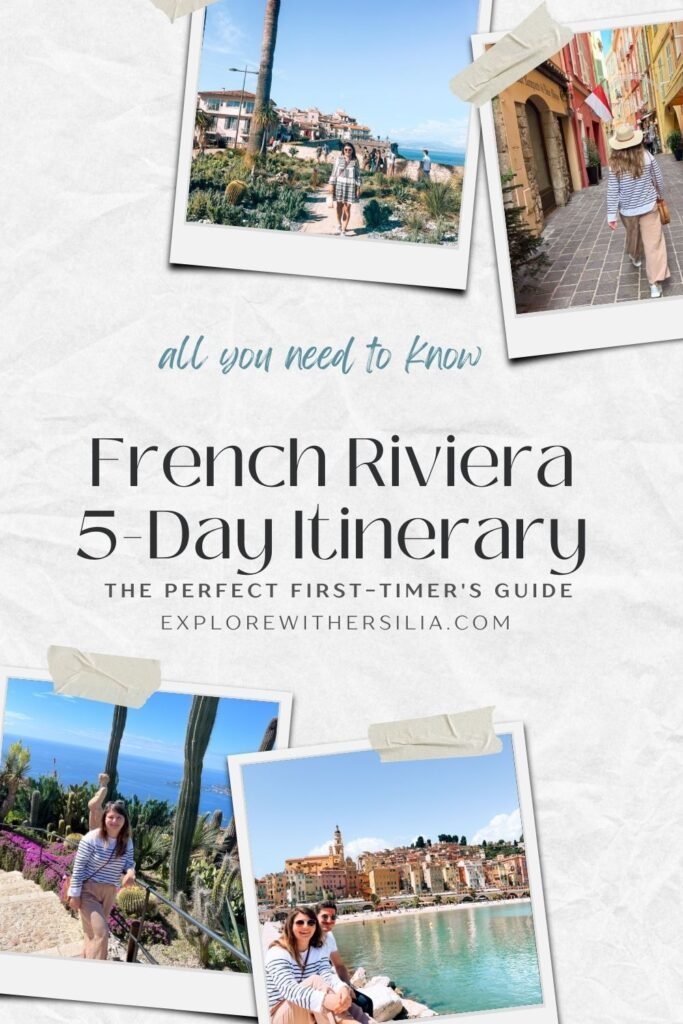
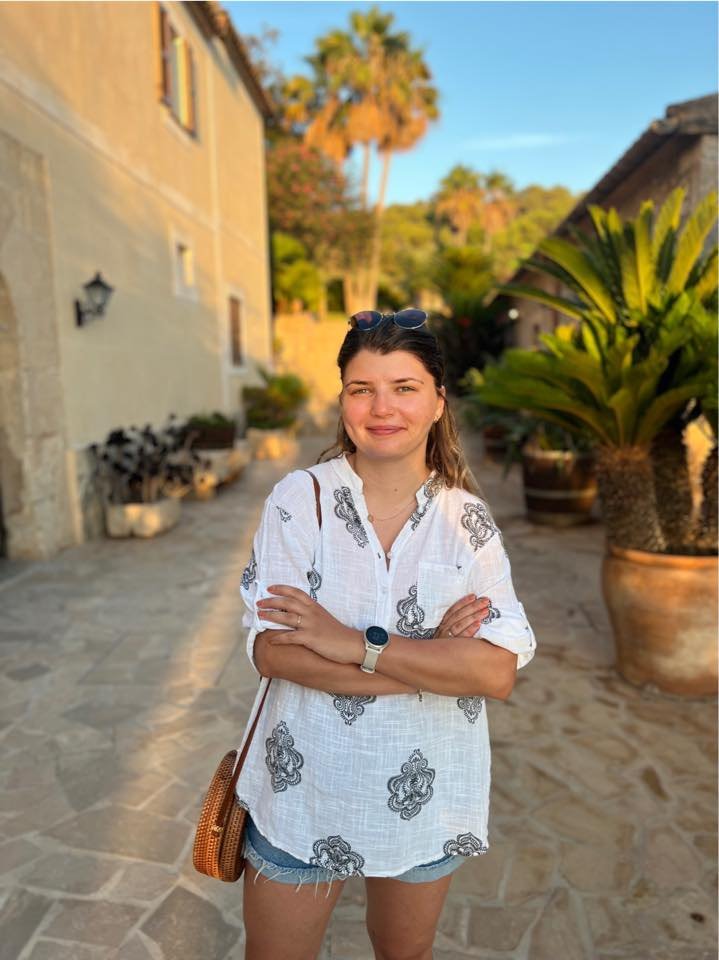
author page / EDITORIAL POLICY PAGE
Hi, I’m Ersilia

Toulouse, France

Originally from Romania

English & French Content
As a Romanian expat living in the heart of southern France, I guide English speakers to discover authentic French experiences without the language barrier. My unique perspective as both a local and an expat allows me to share insider tips, cultural insights, and practical advice that you won’t find in typical guidebooks.
My Expertise:
- French life and culture navigation
- Hidden gems across French regions
- Eastern vs Western European perspectives
- Local insights and practical travel tips
Blog Socials
Personal Pages

